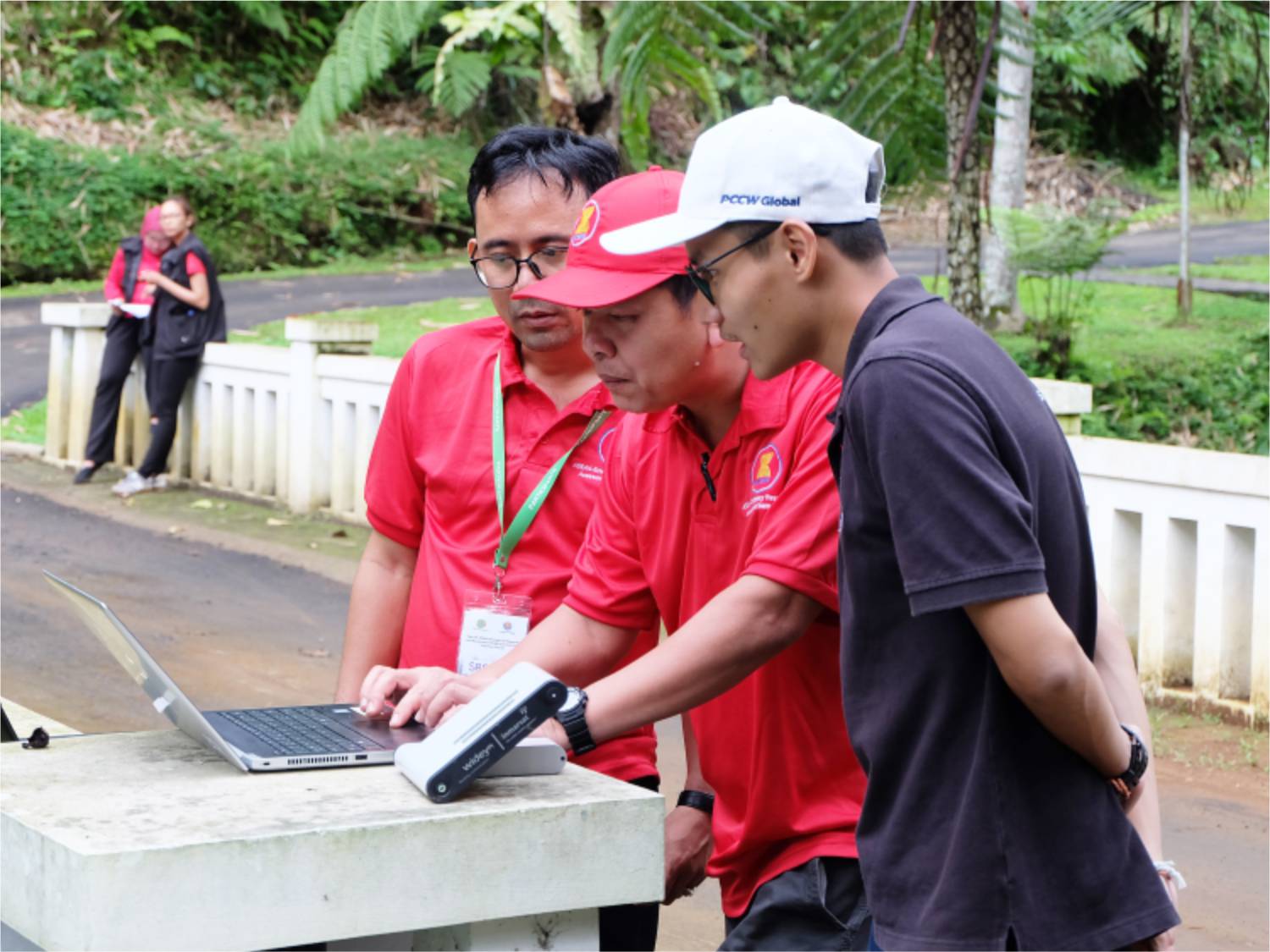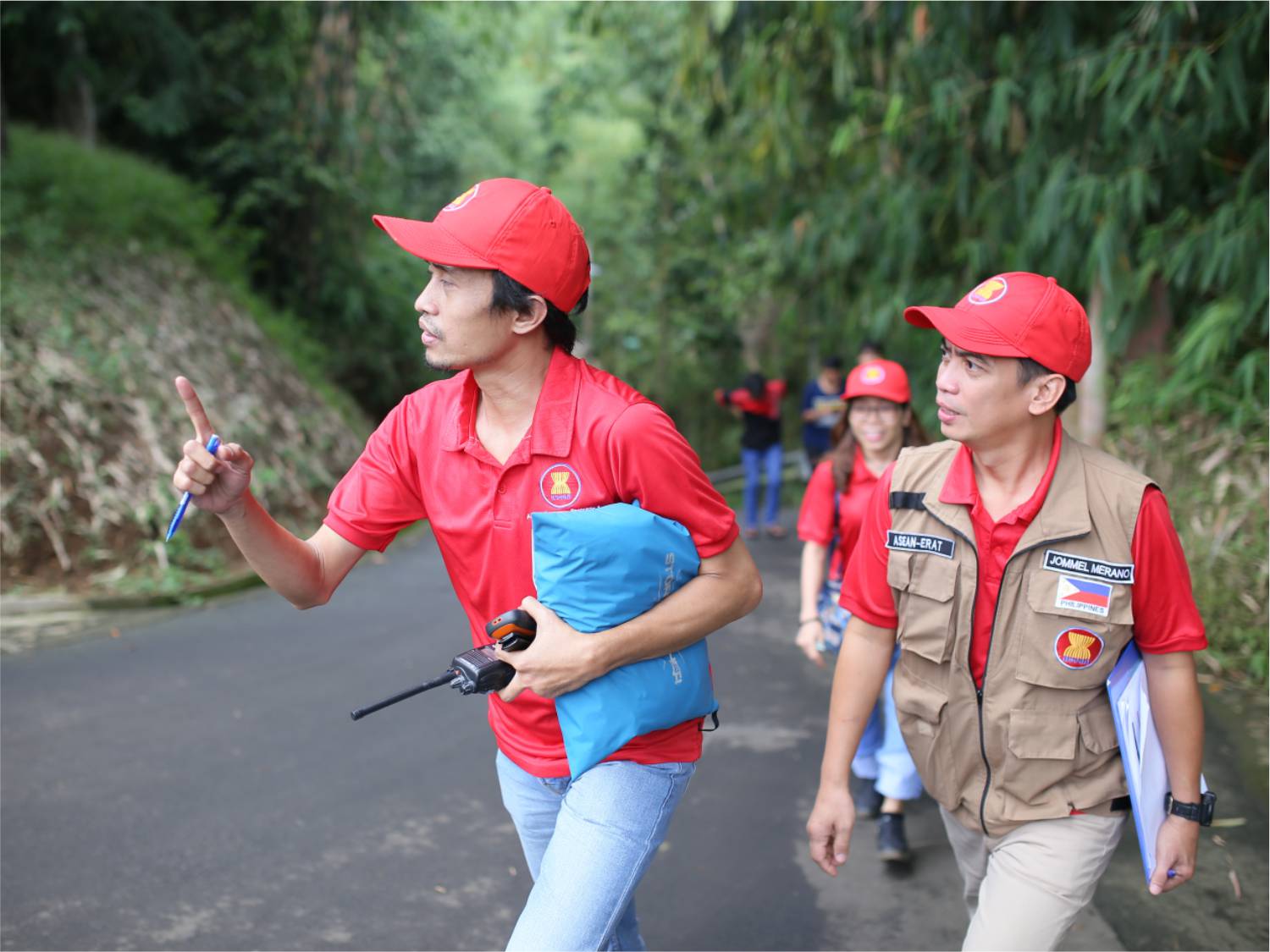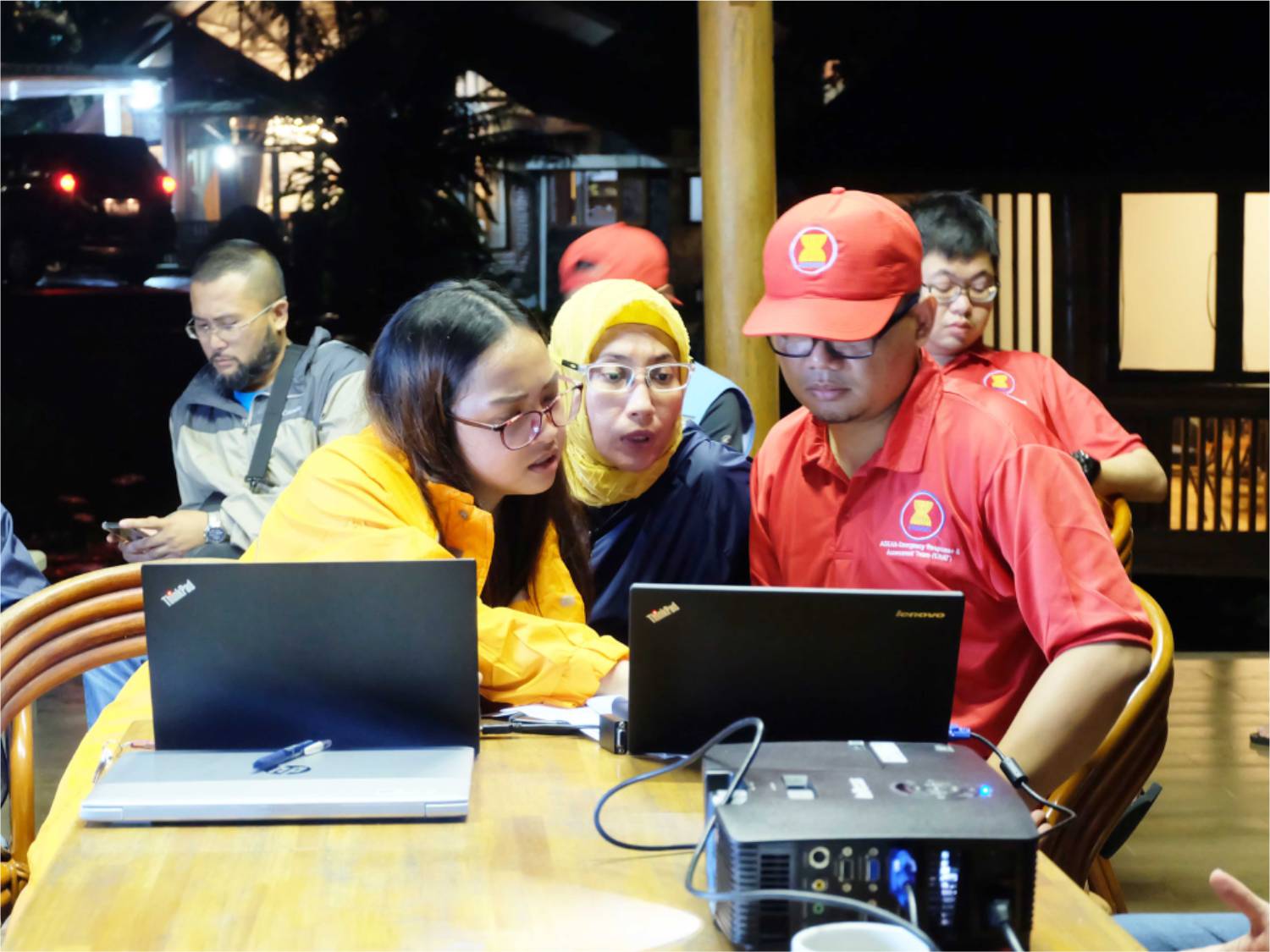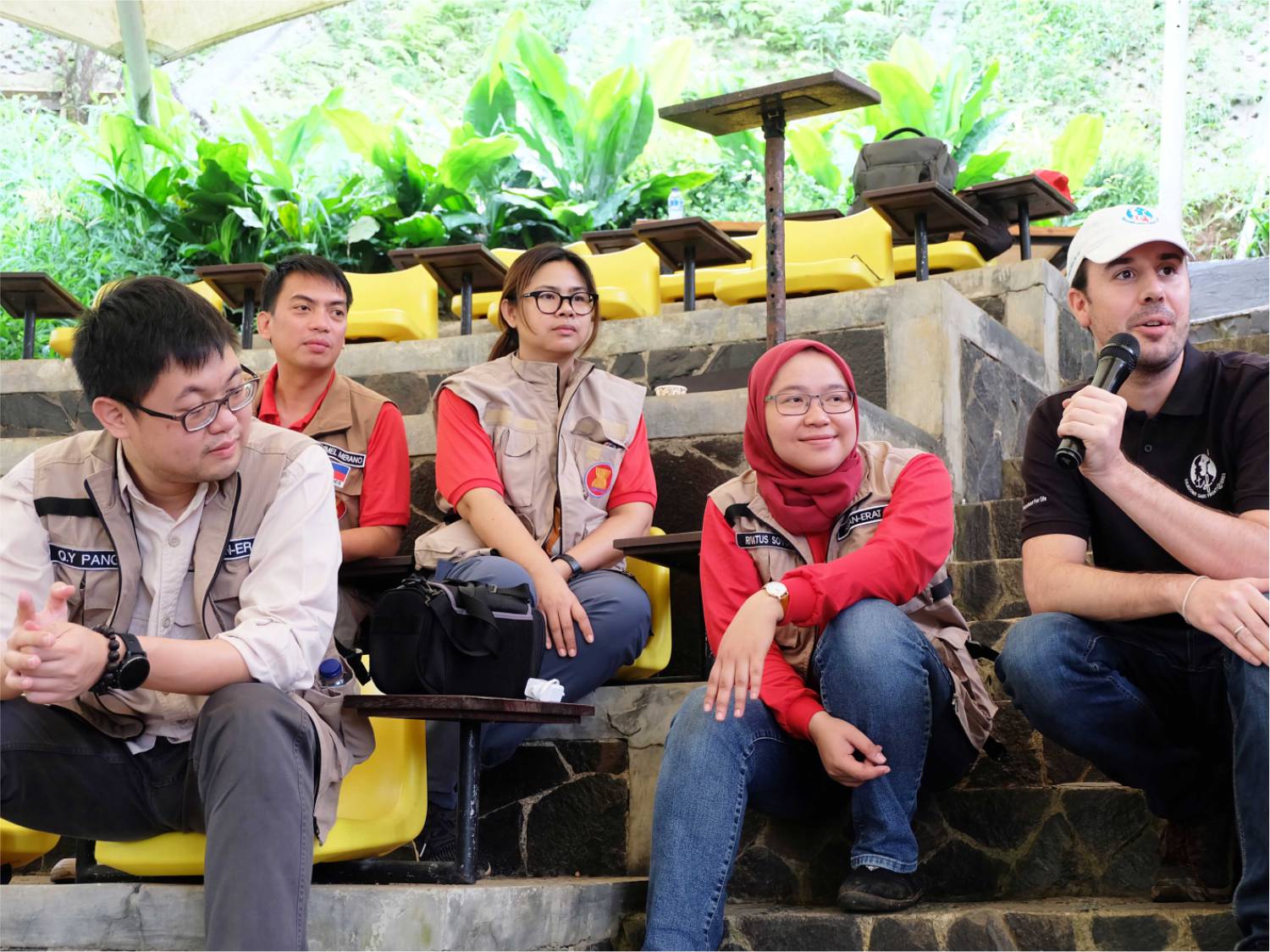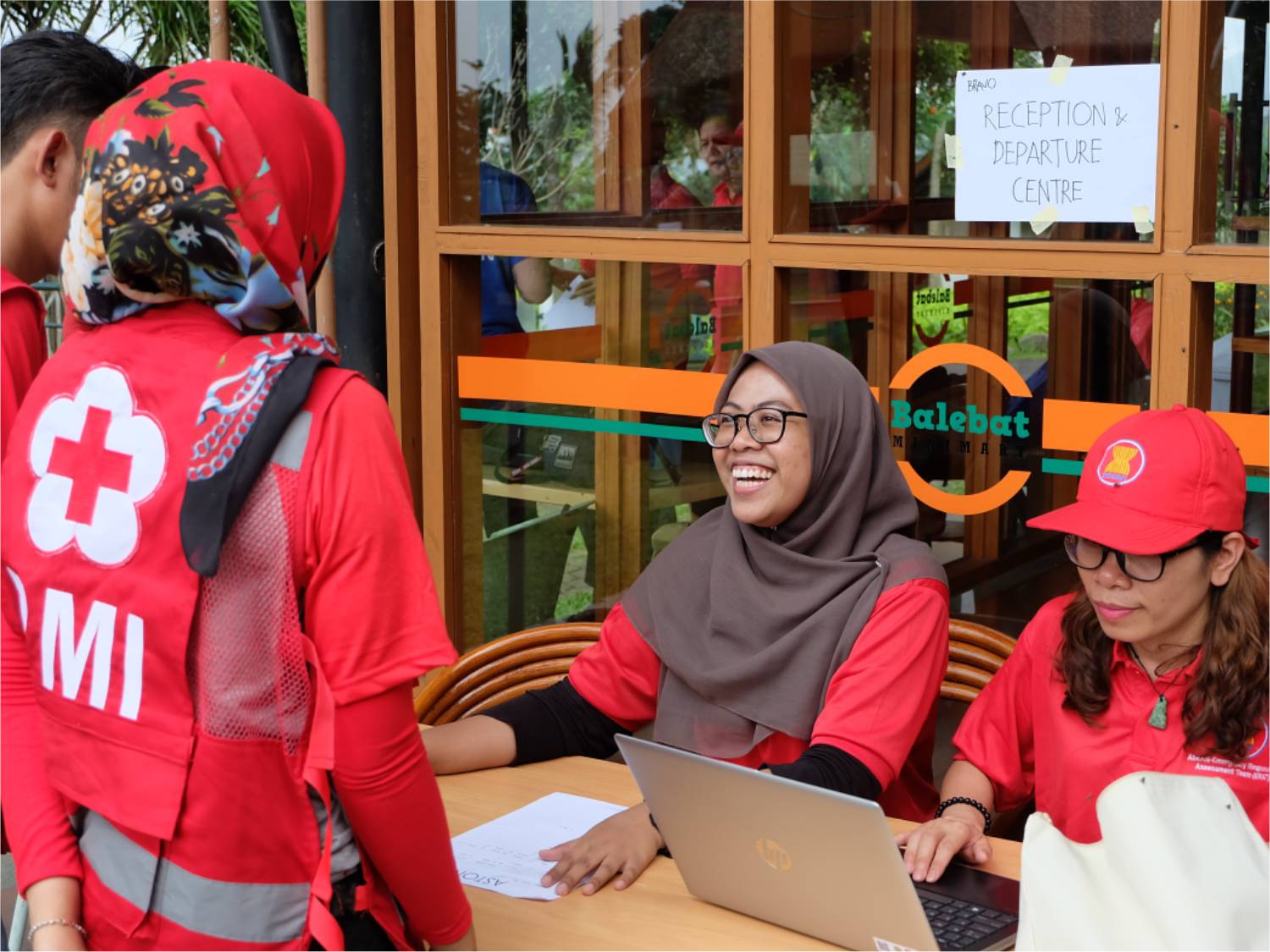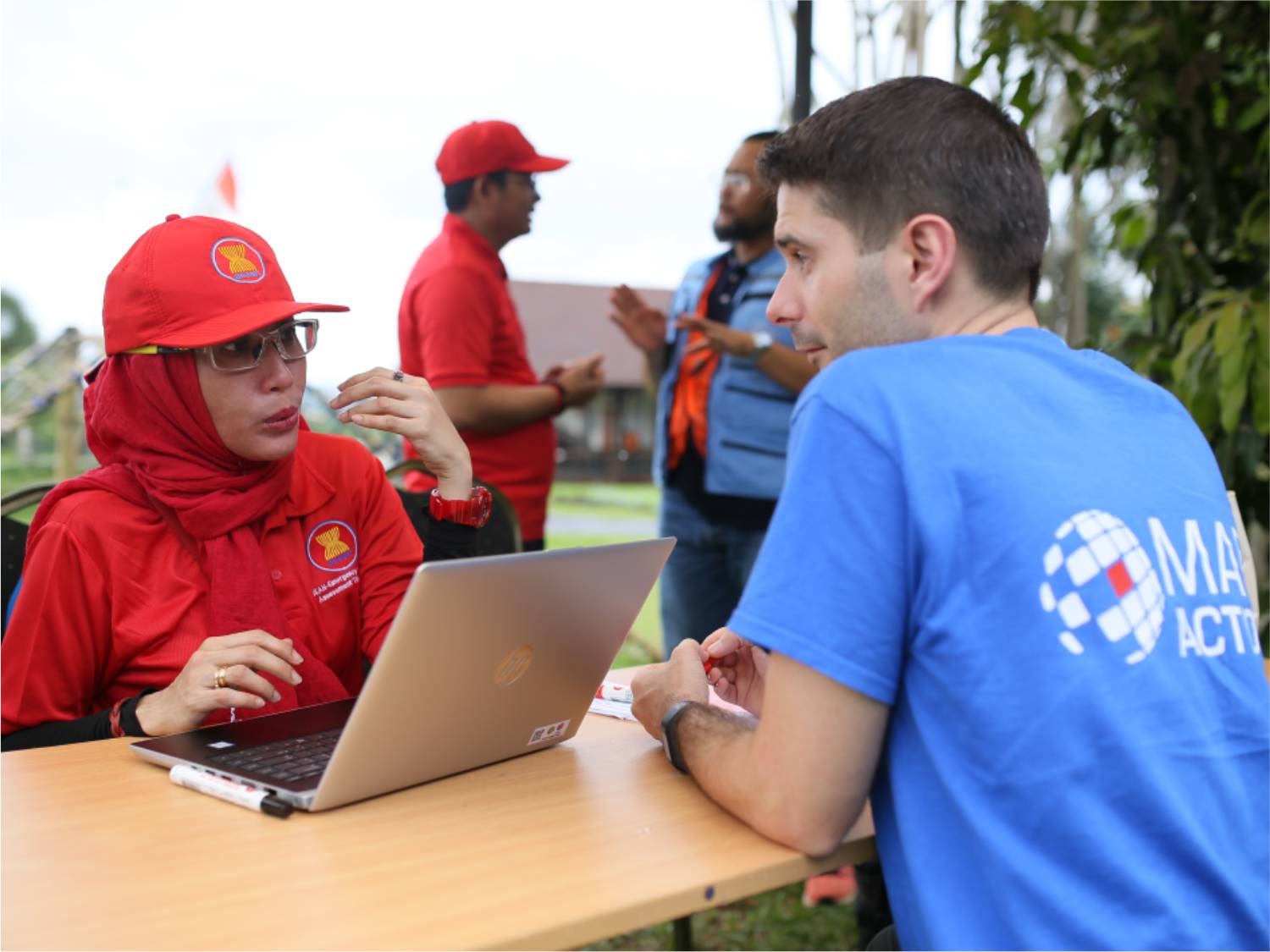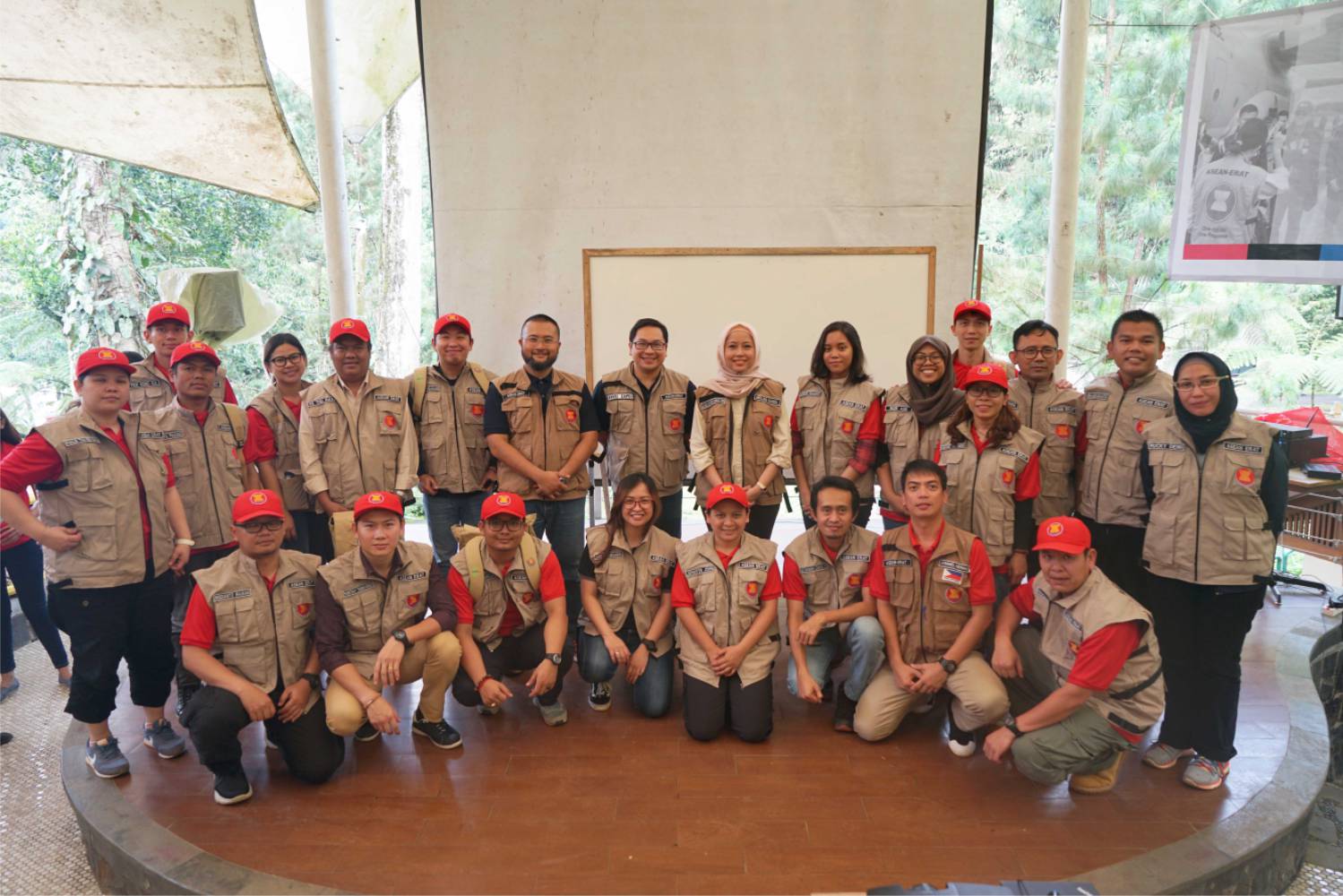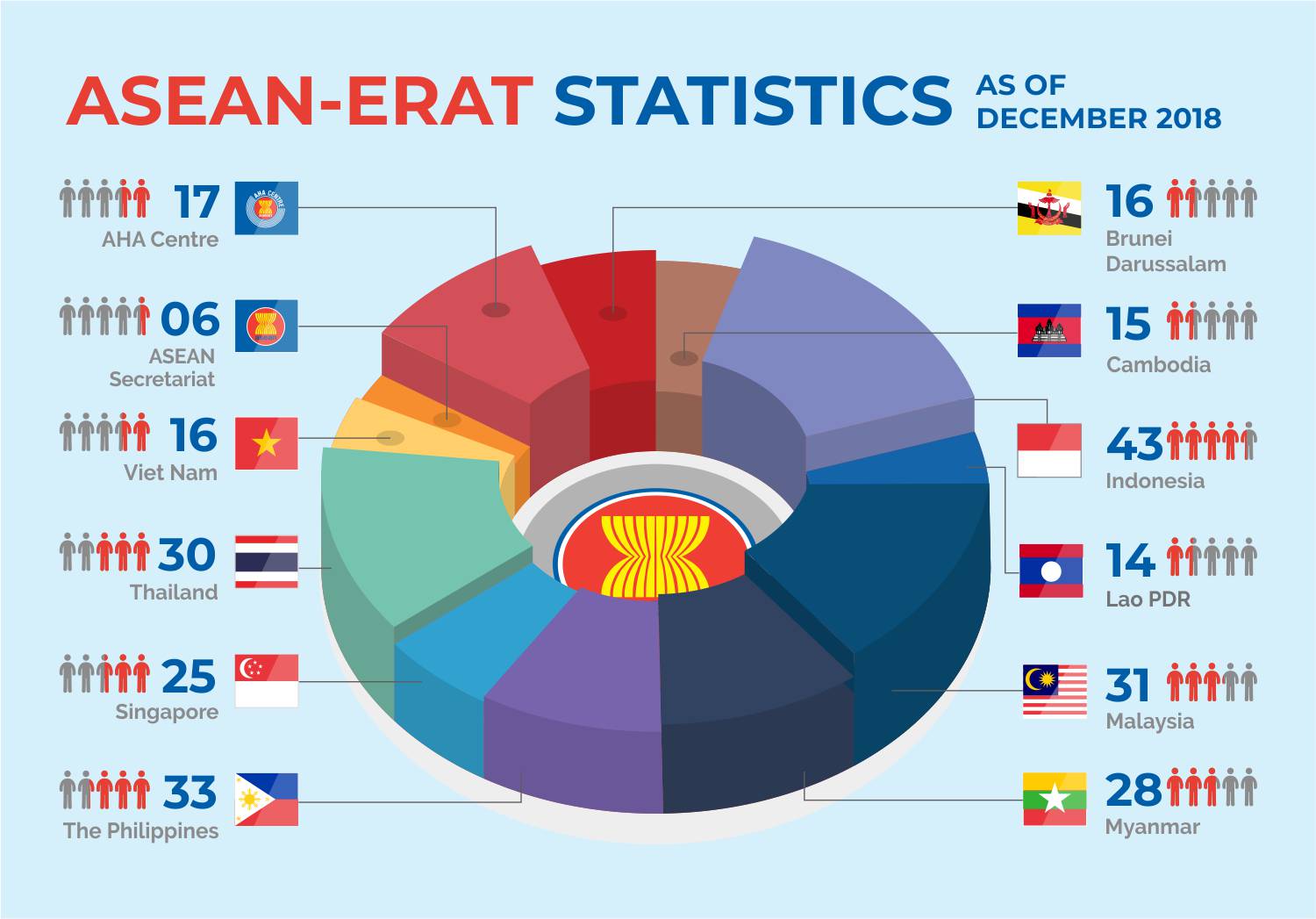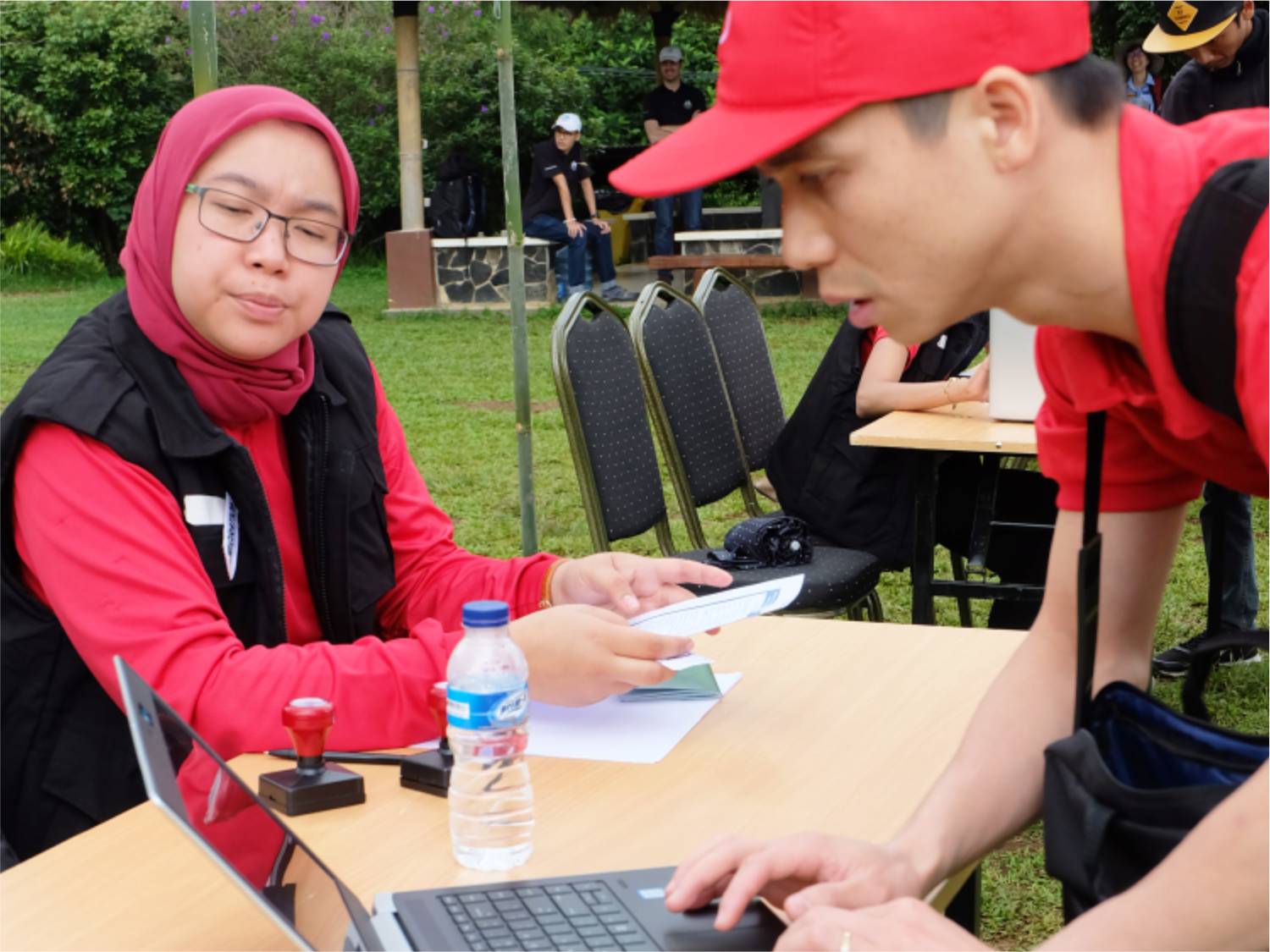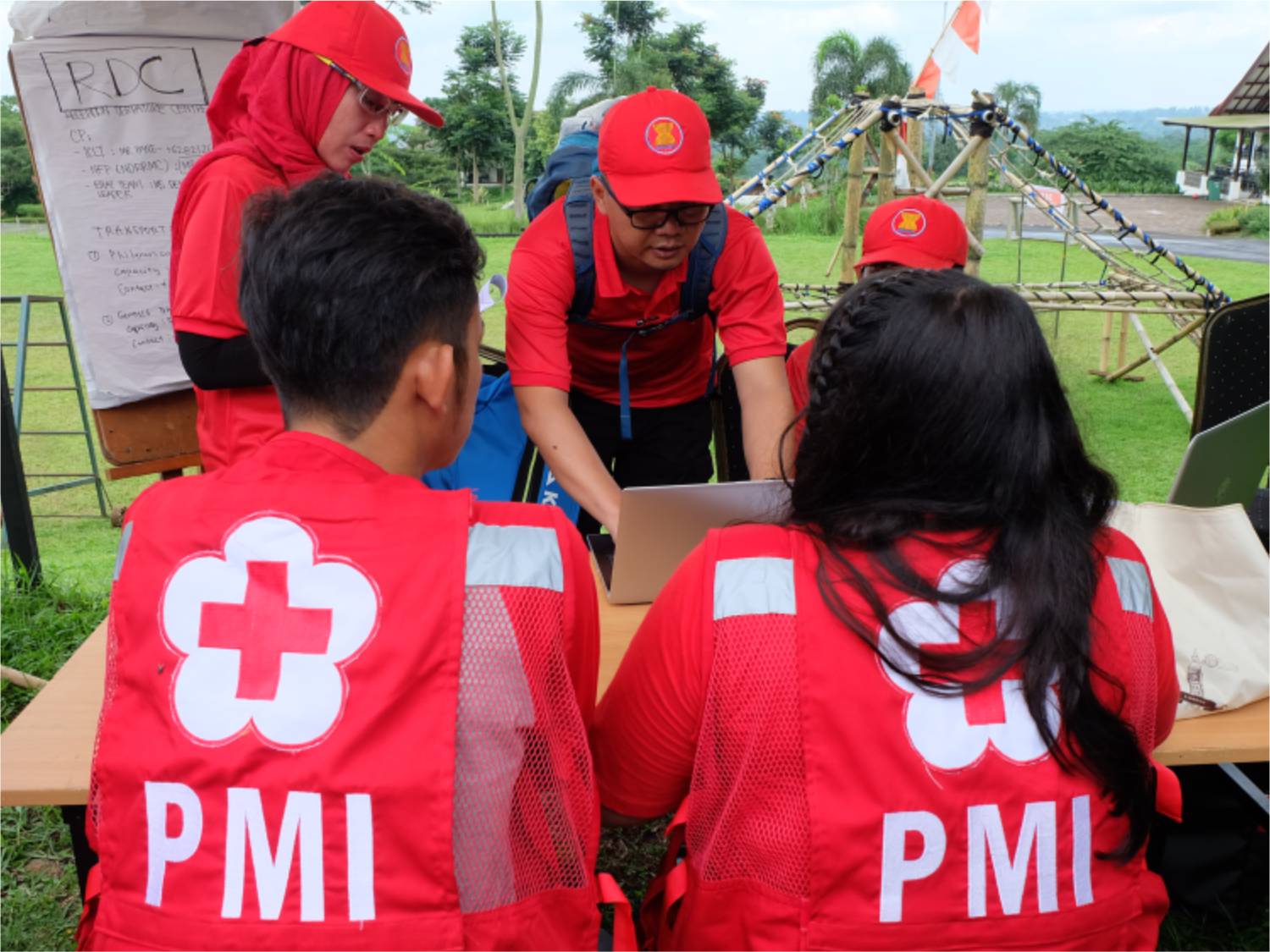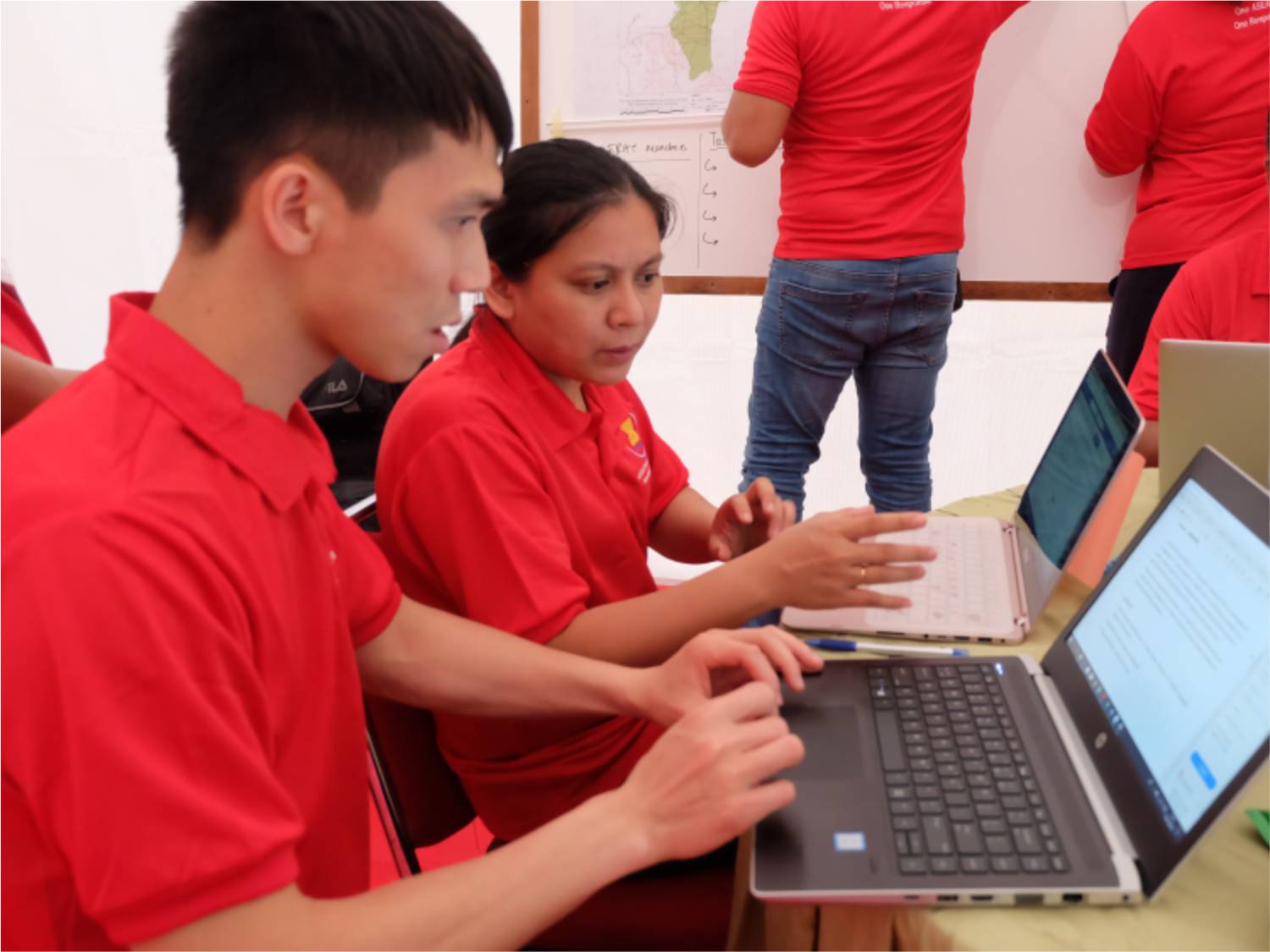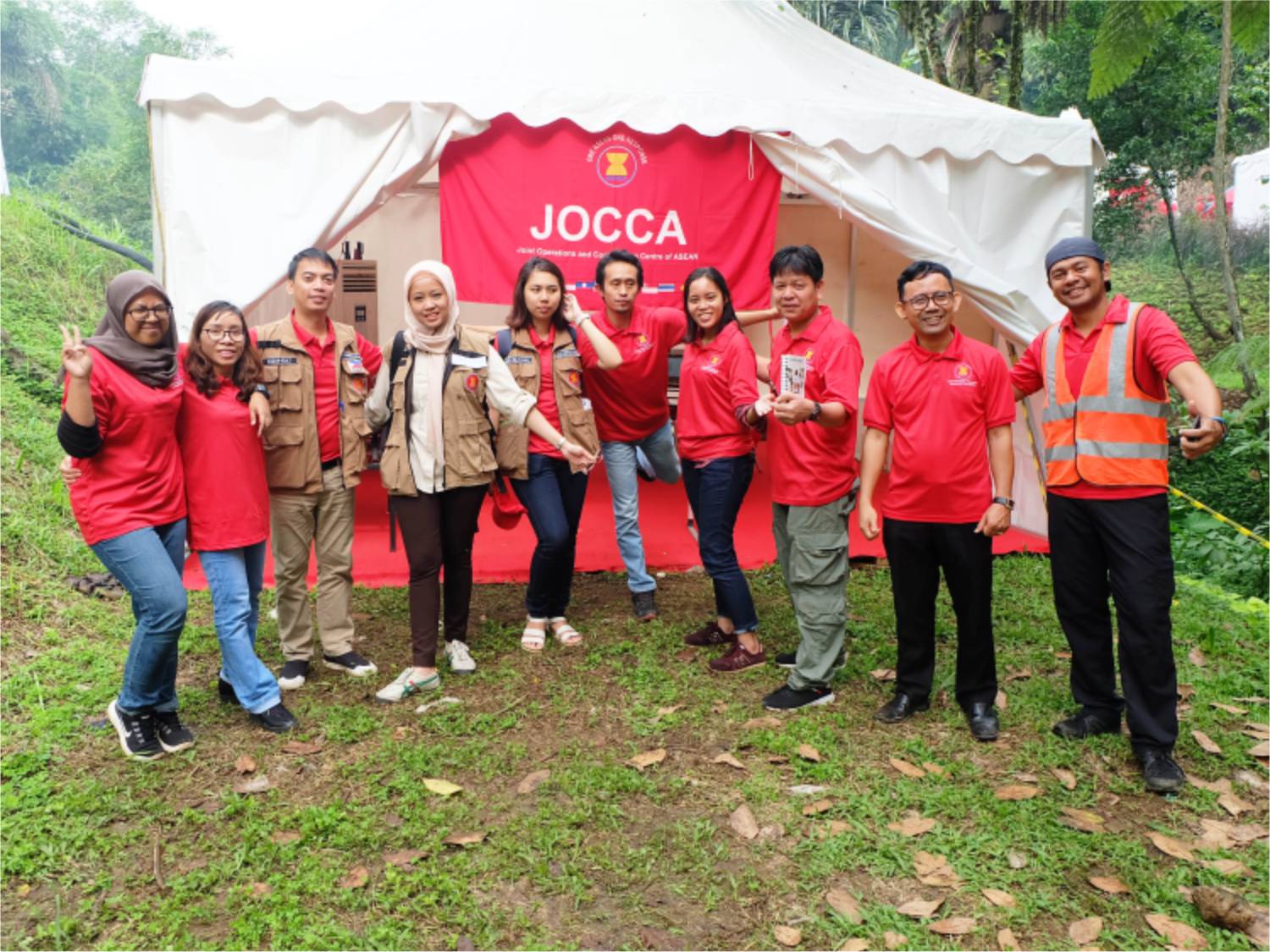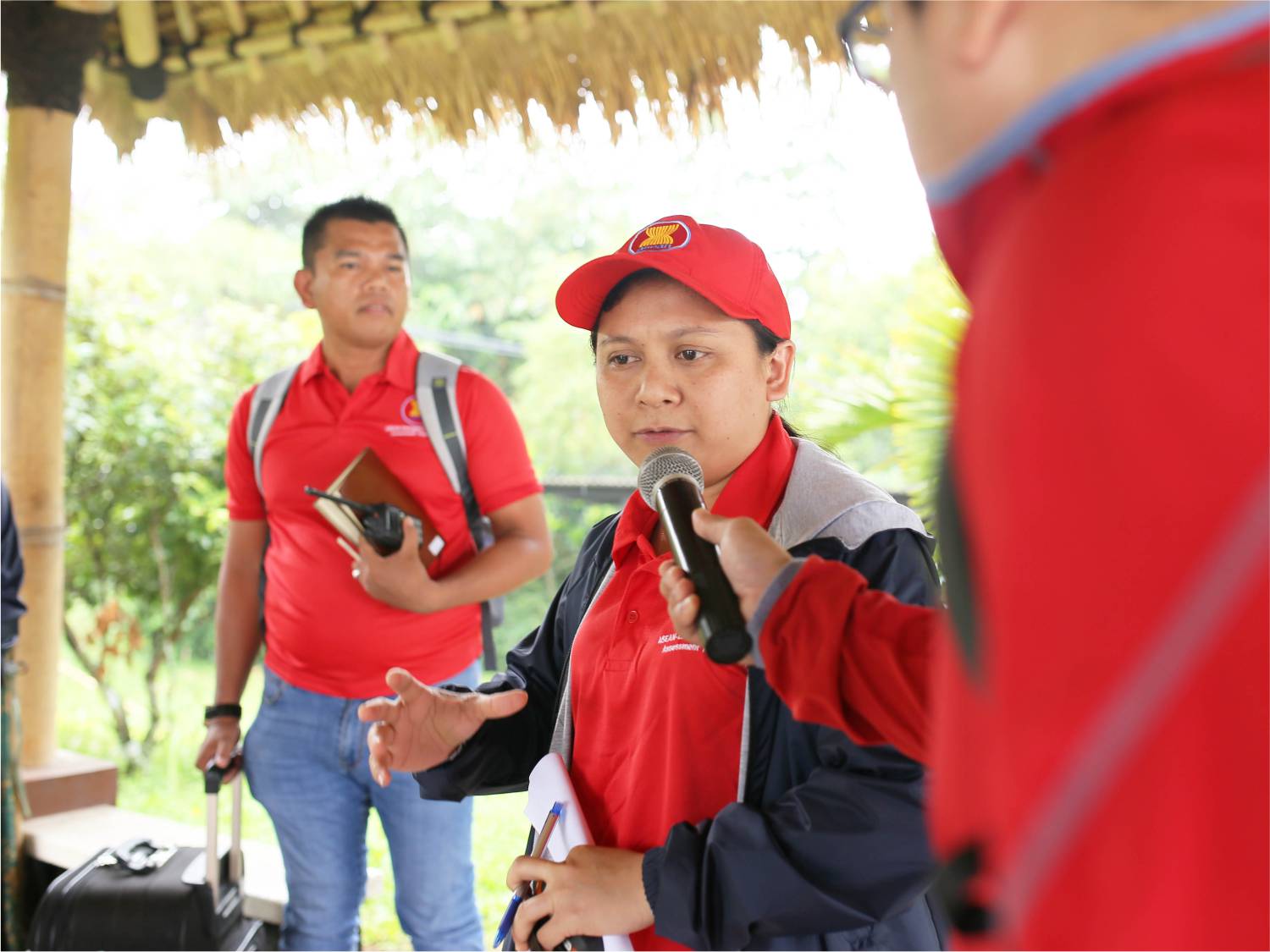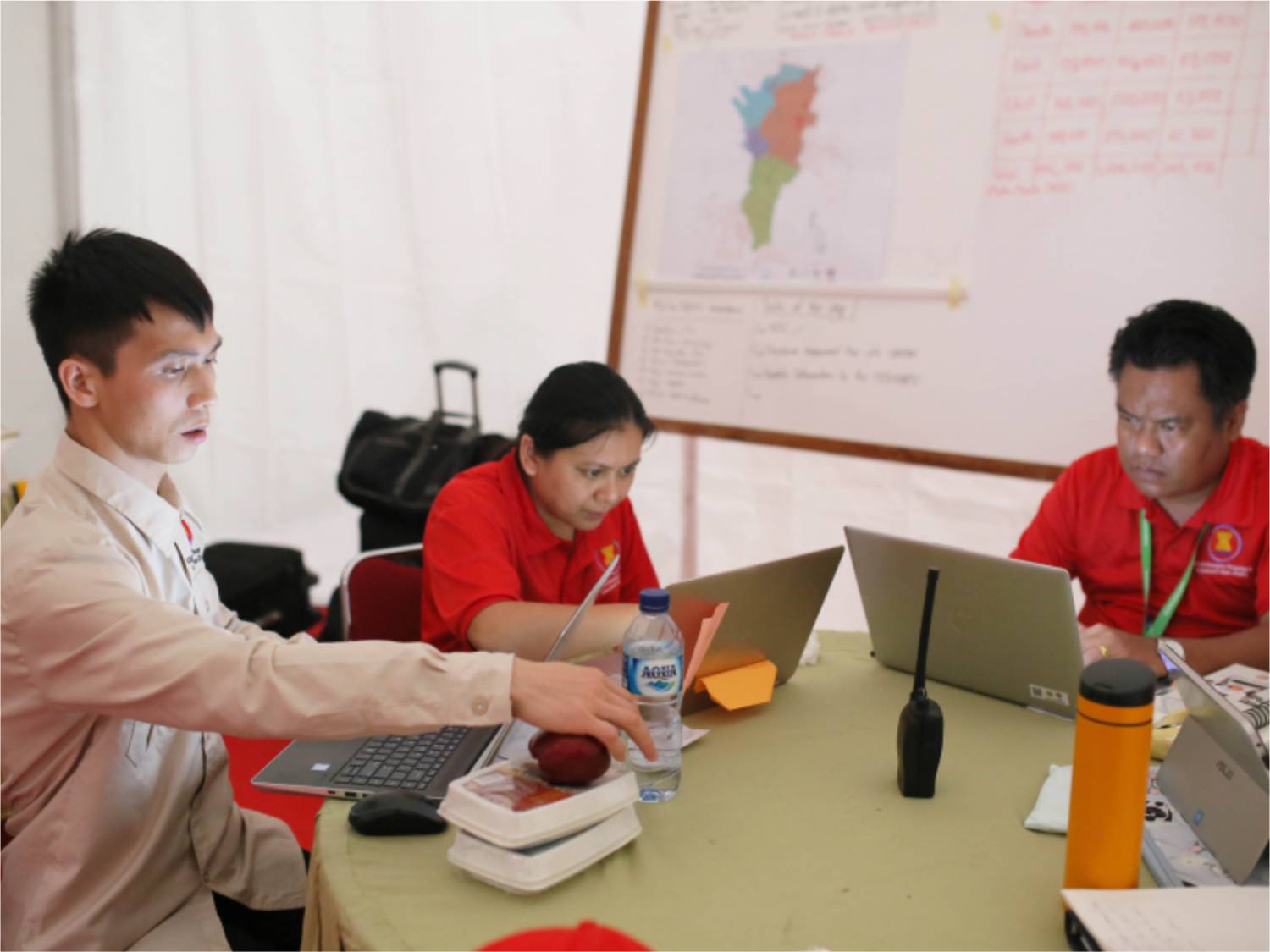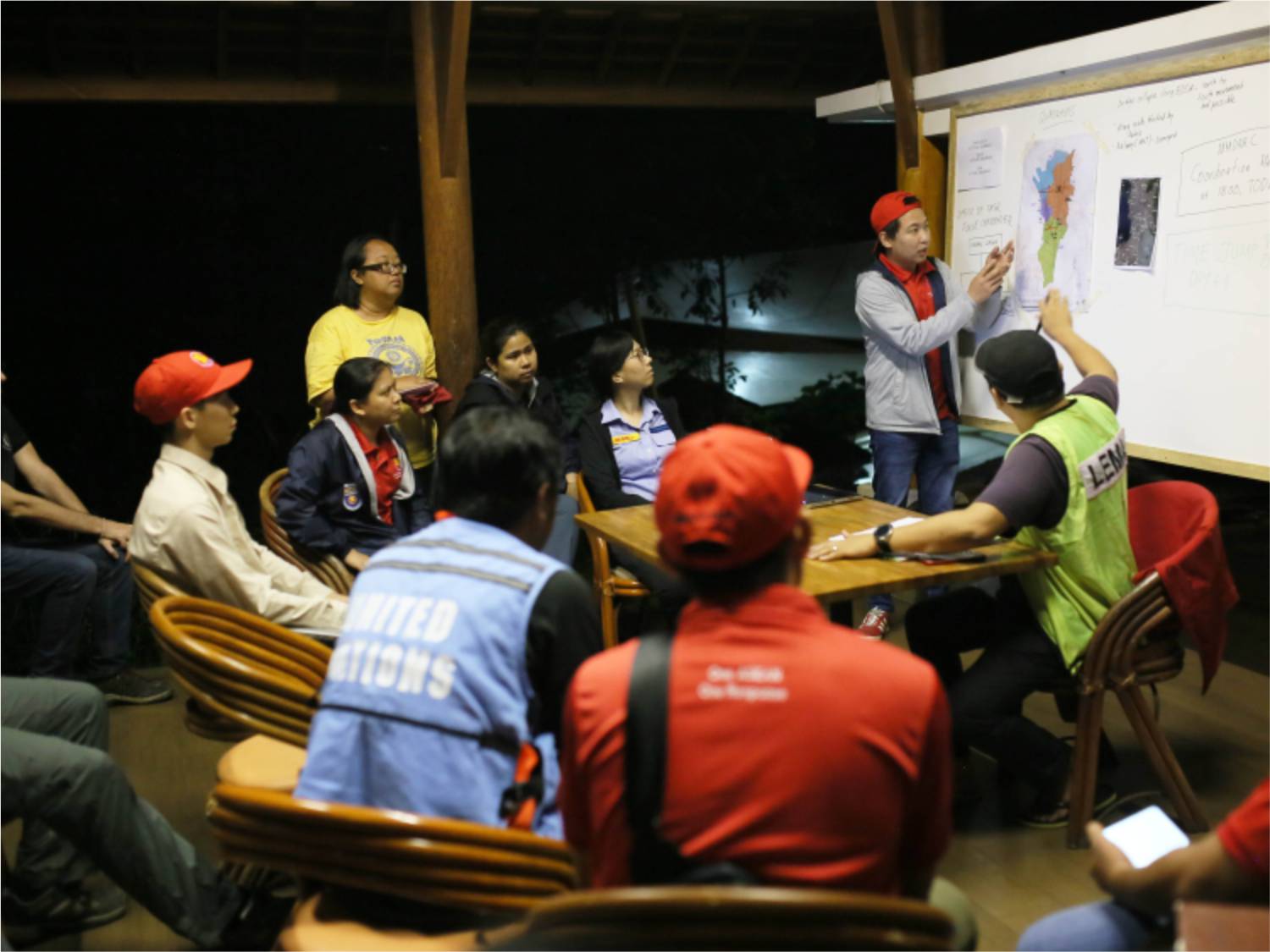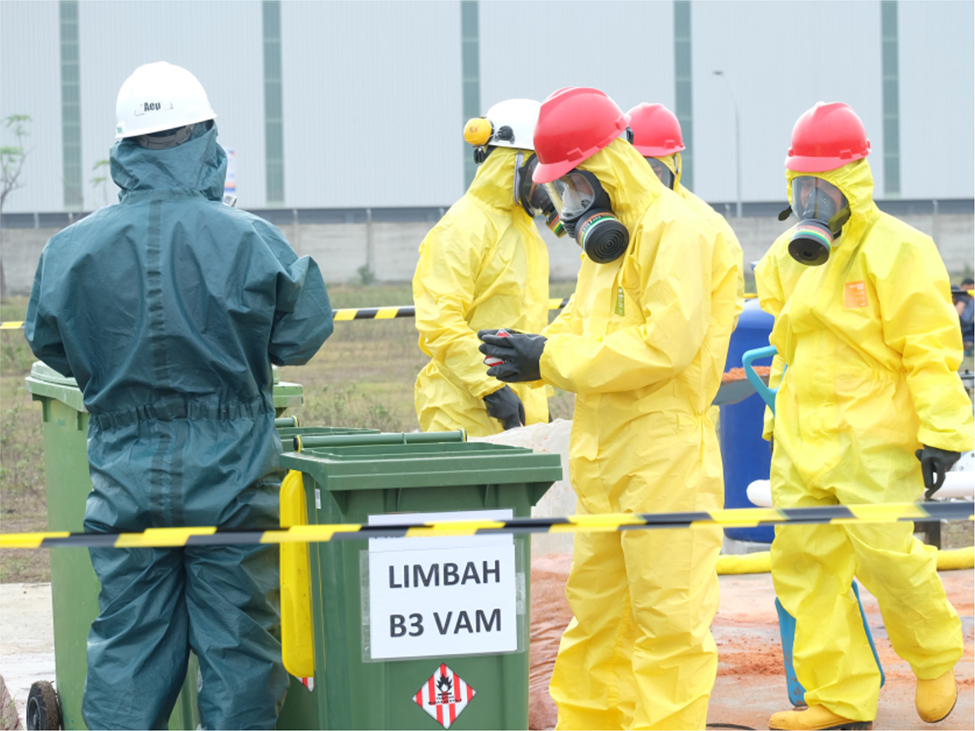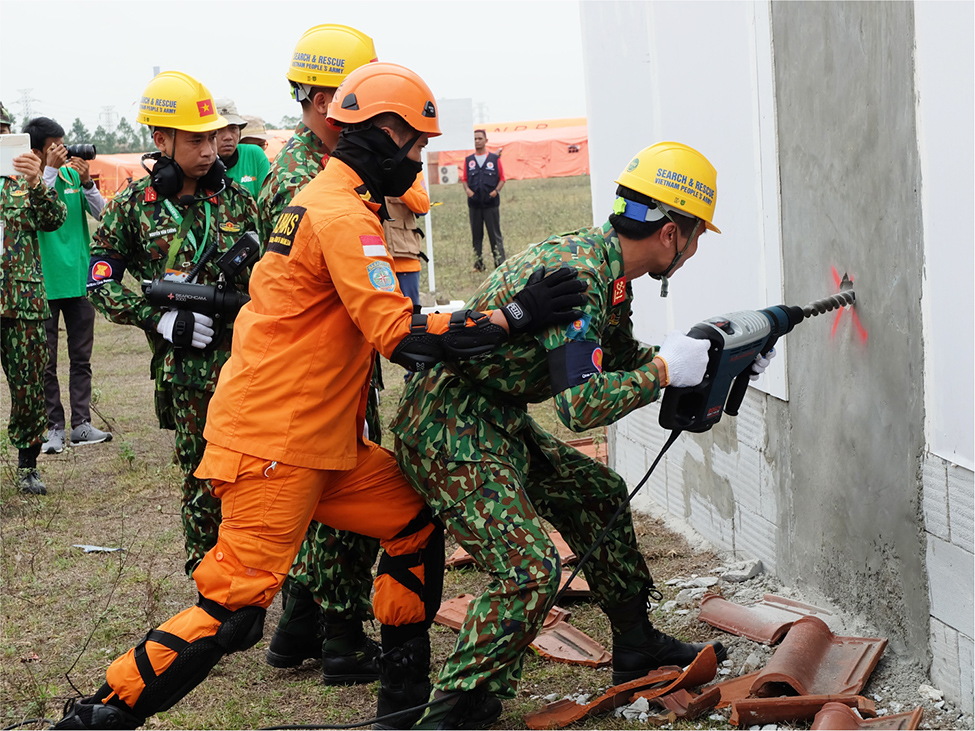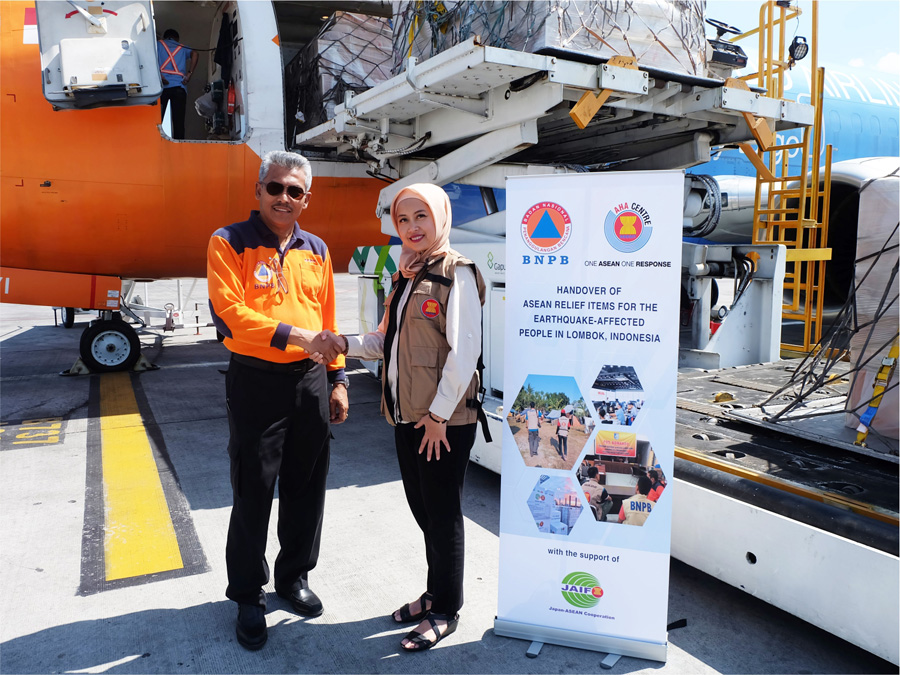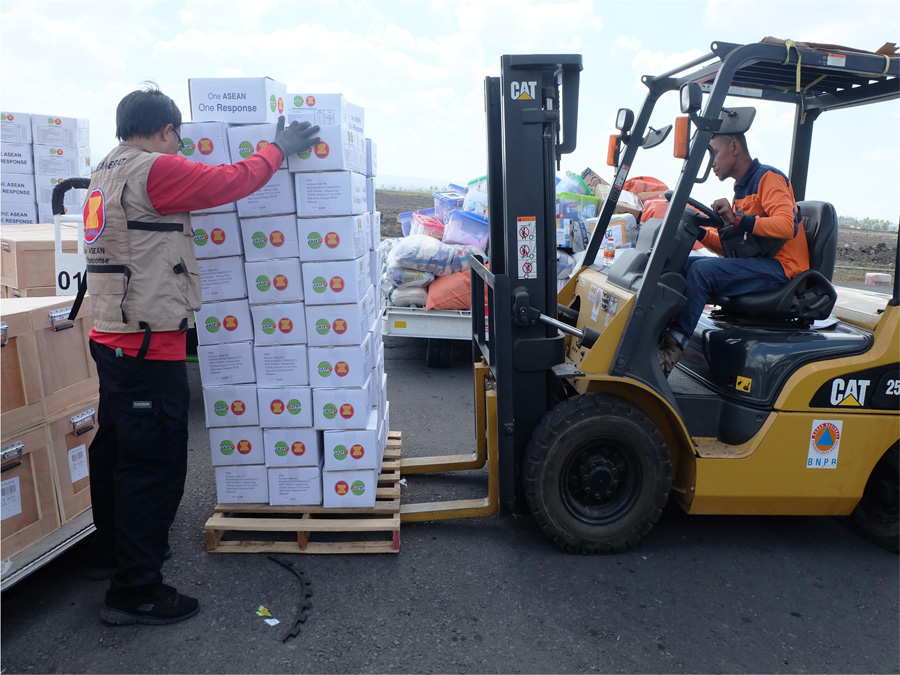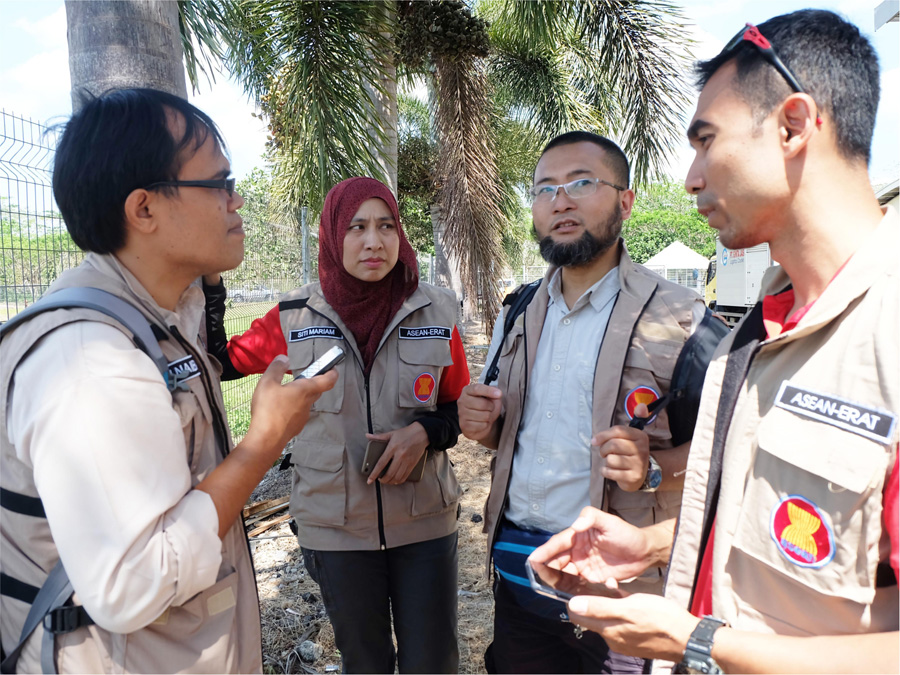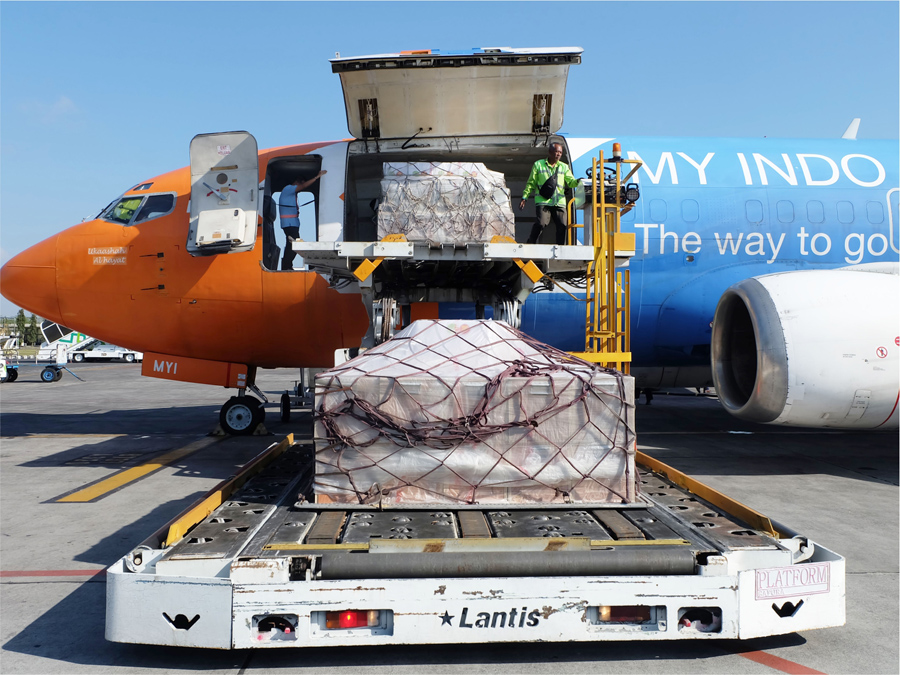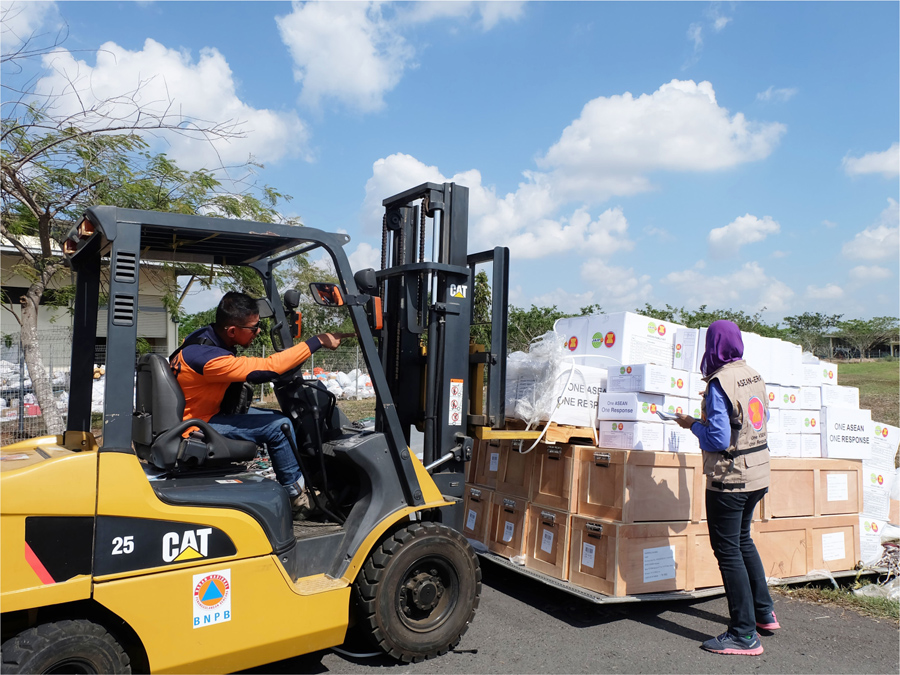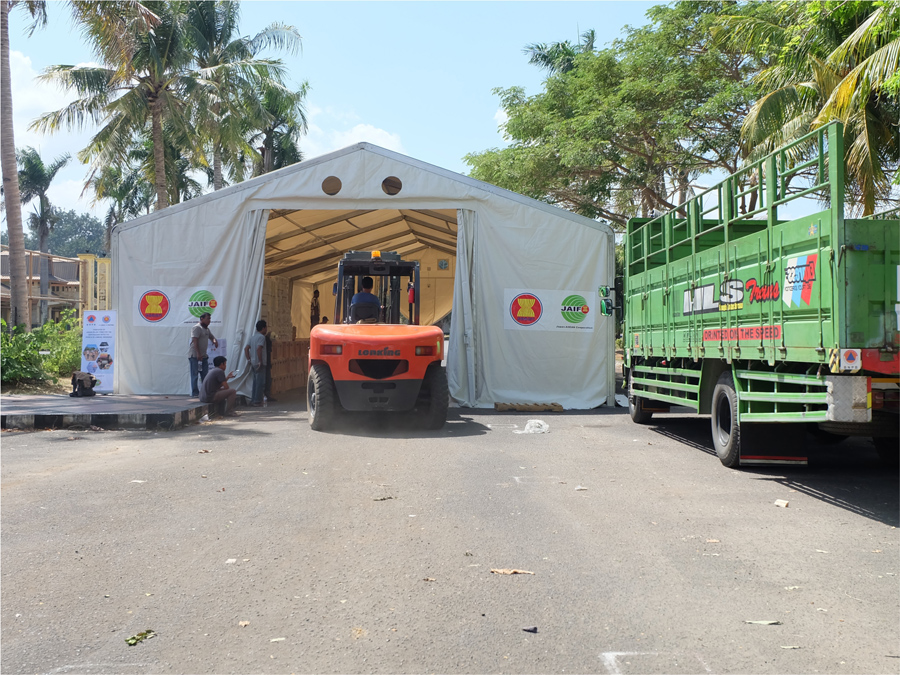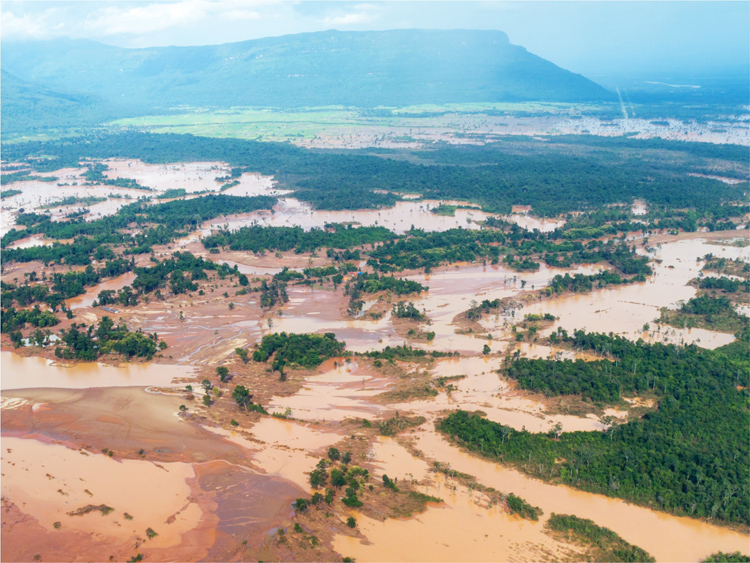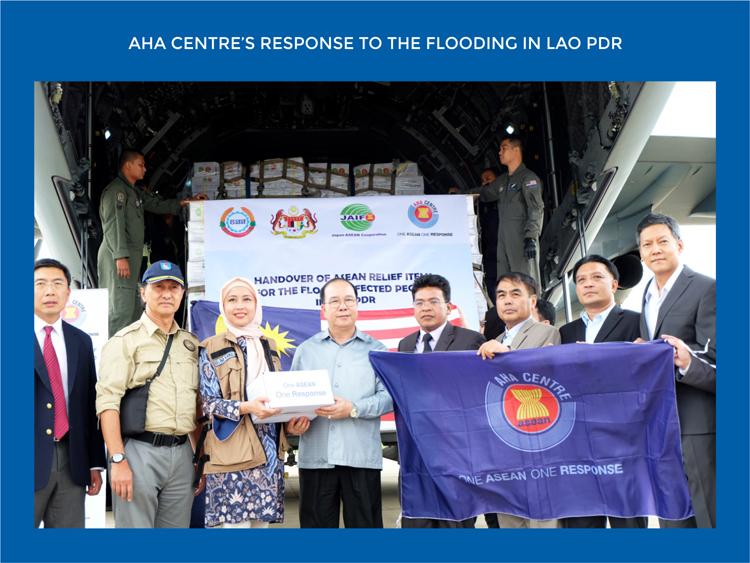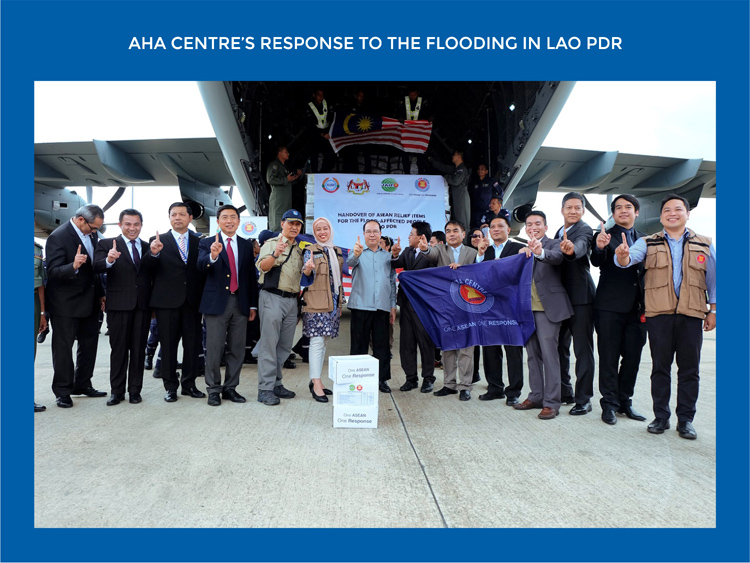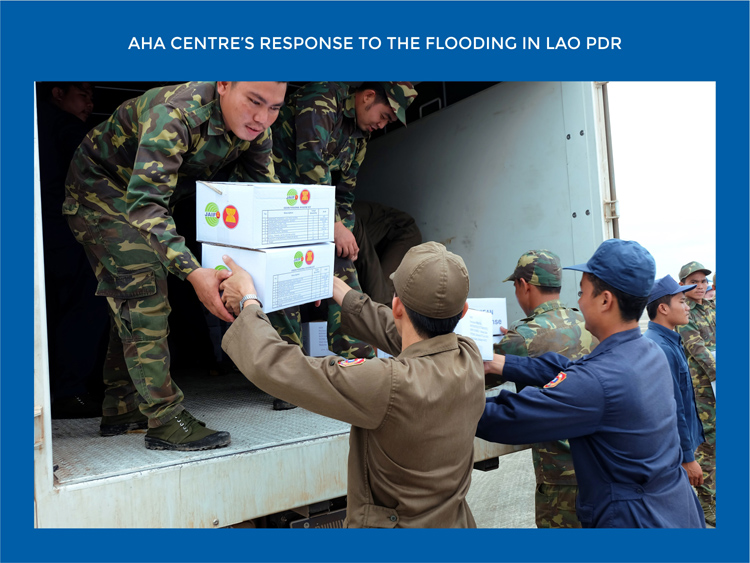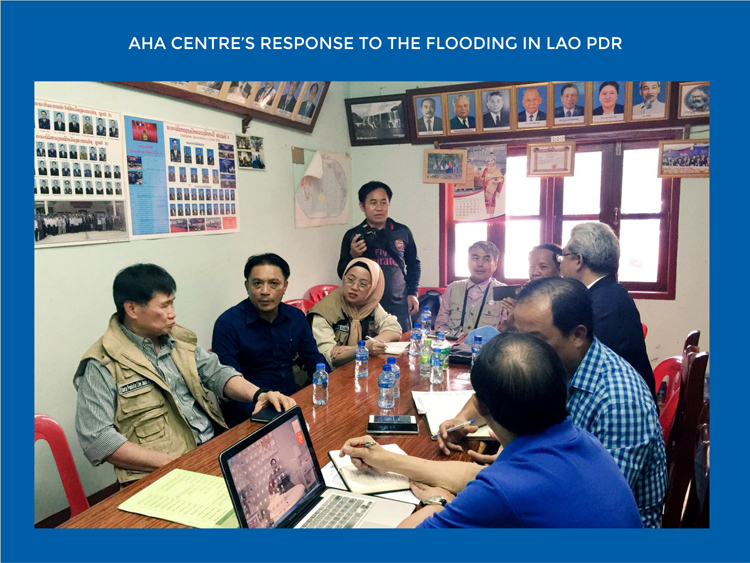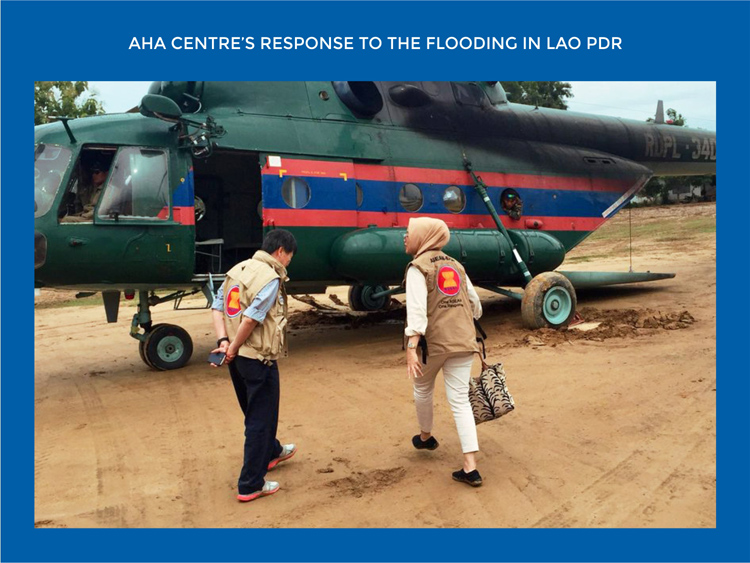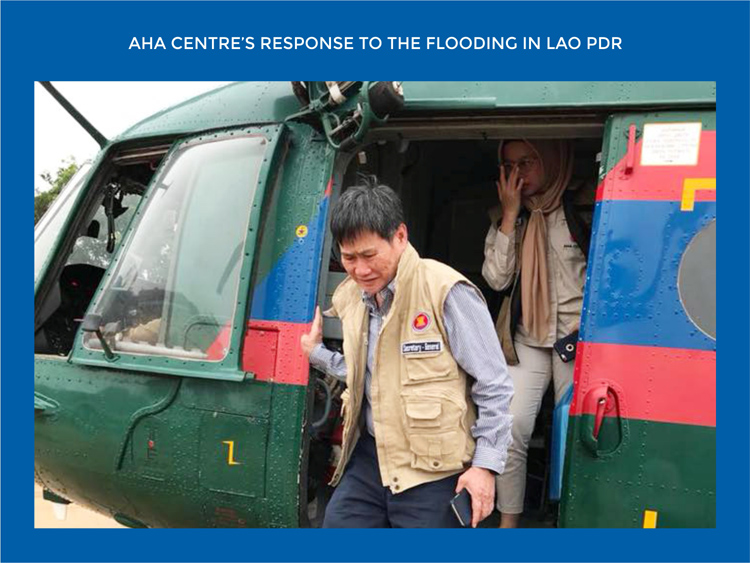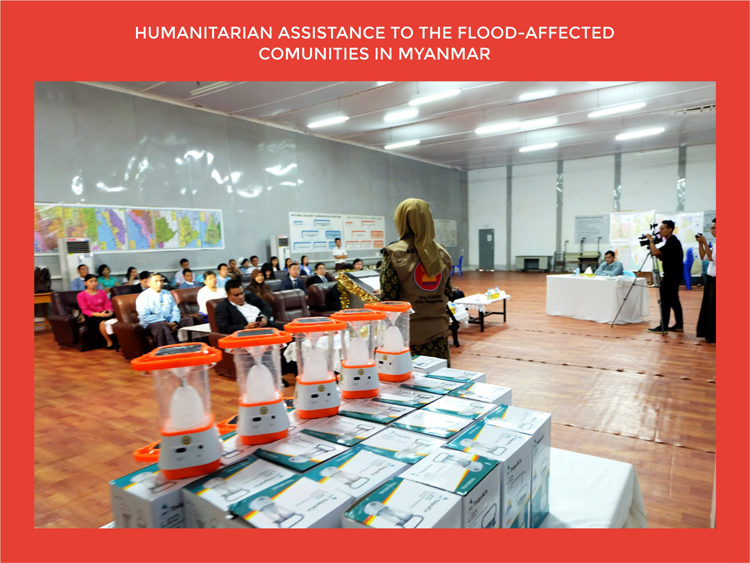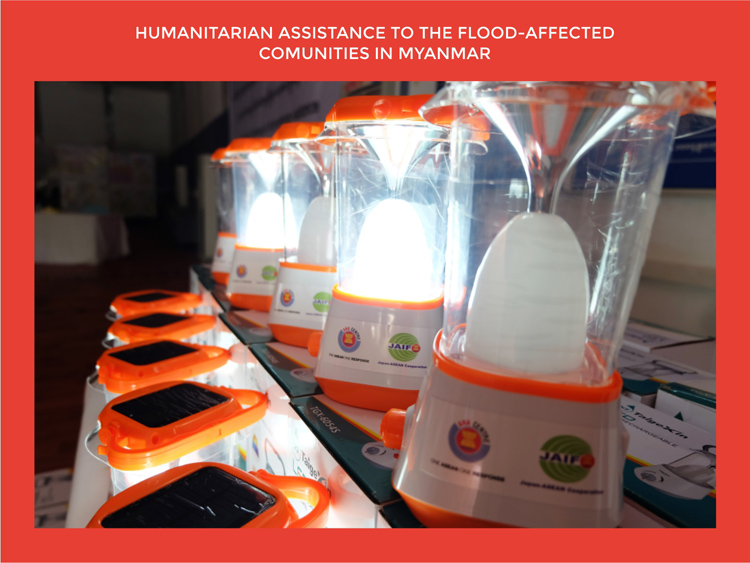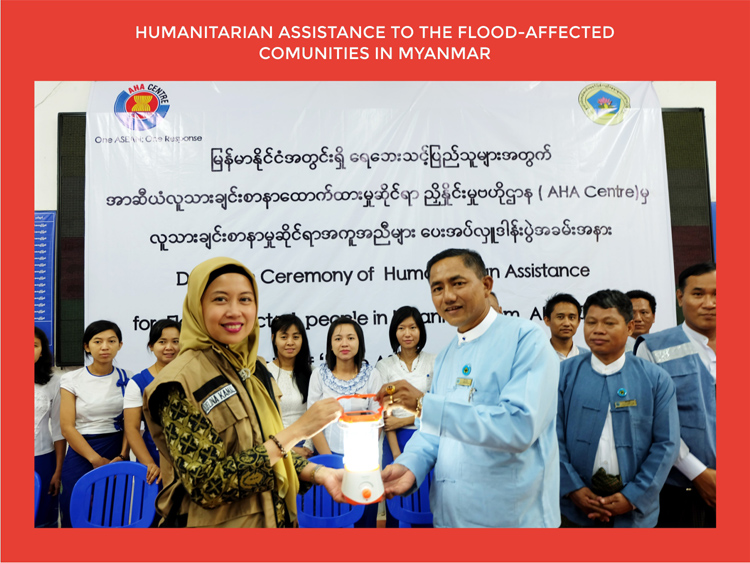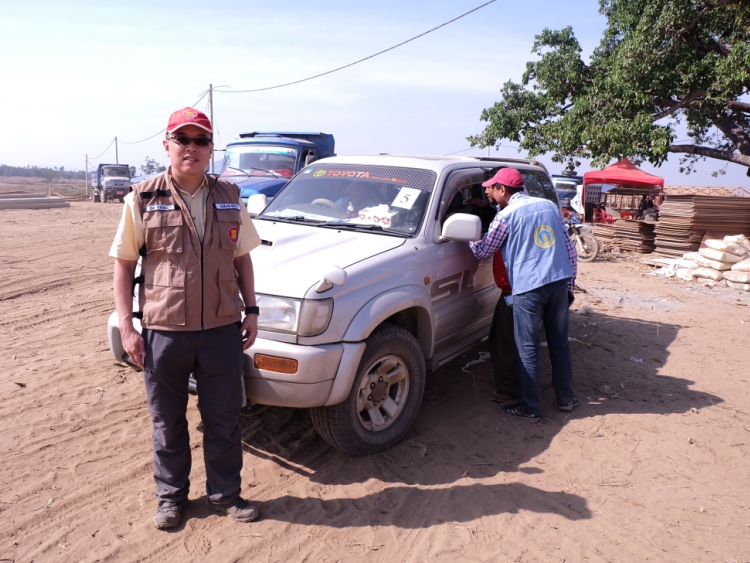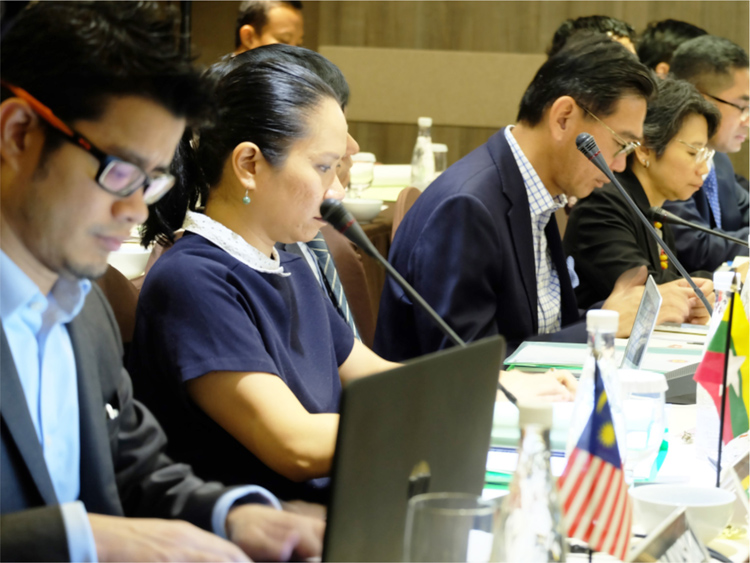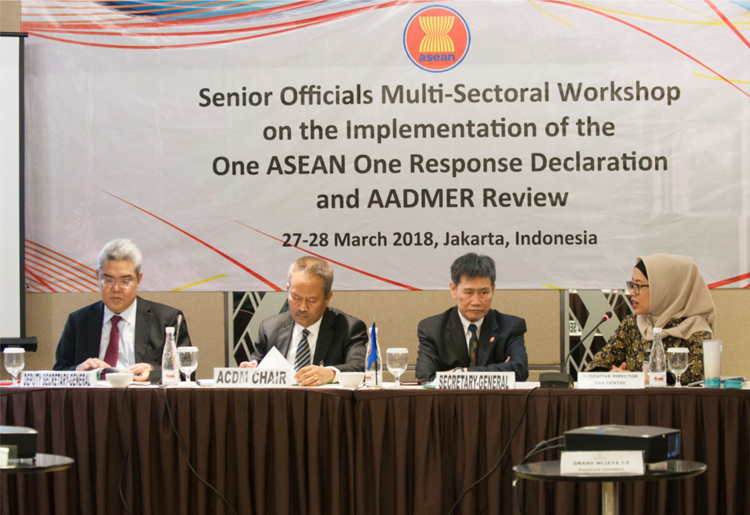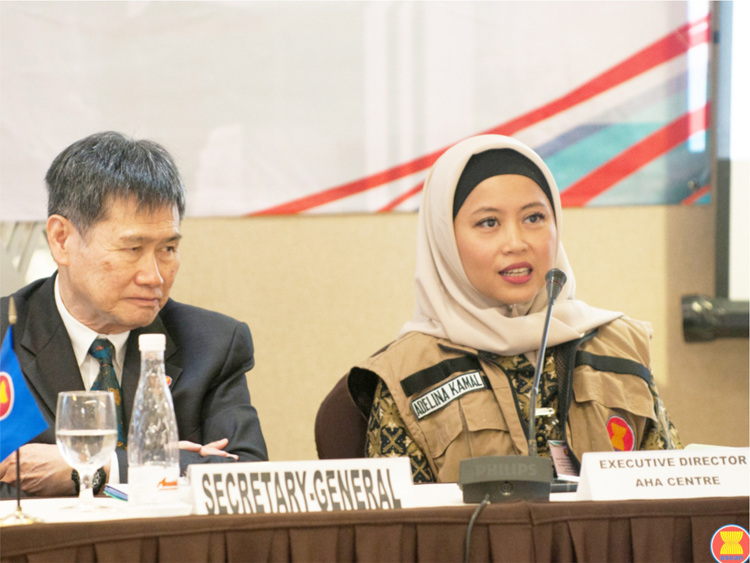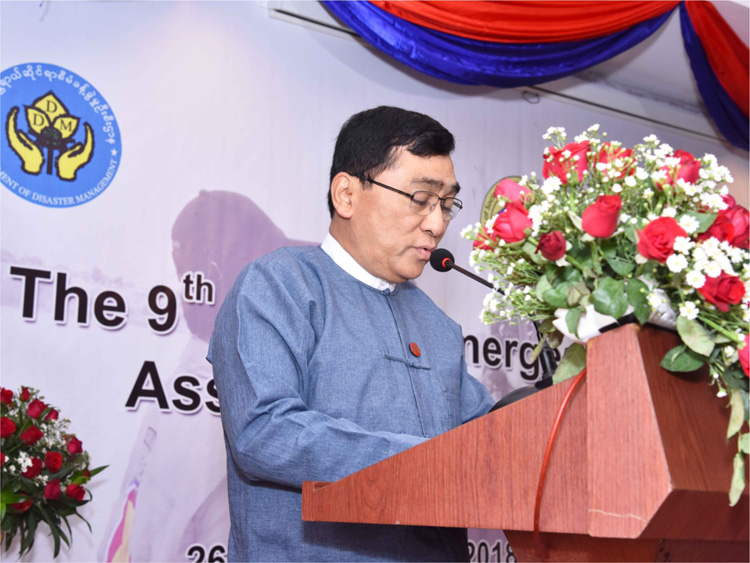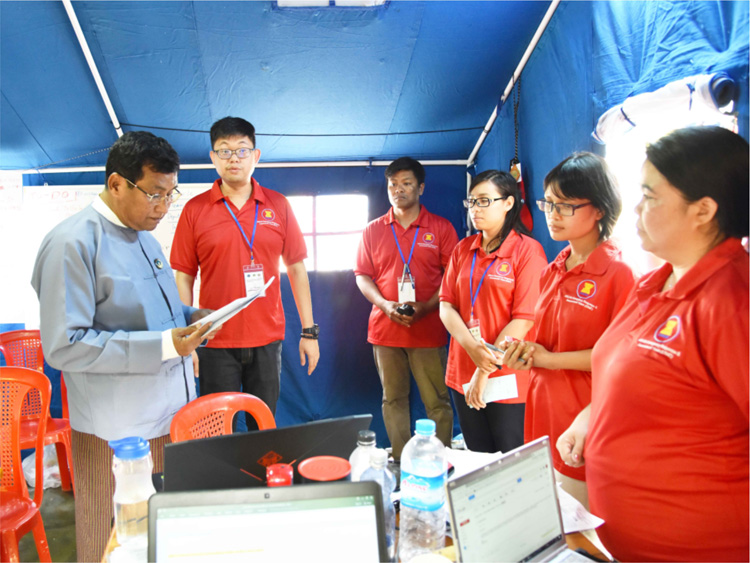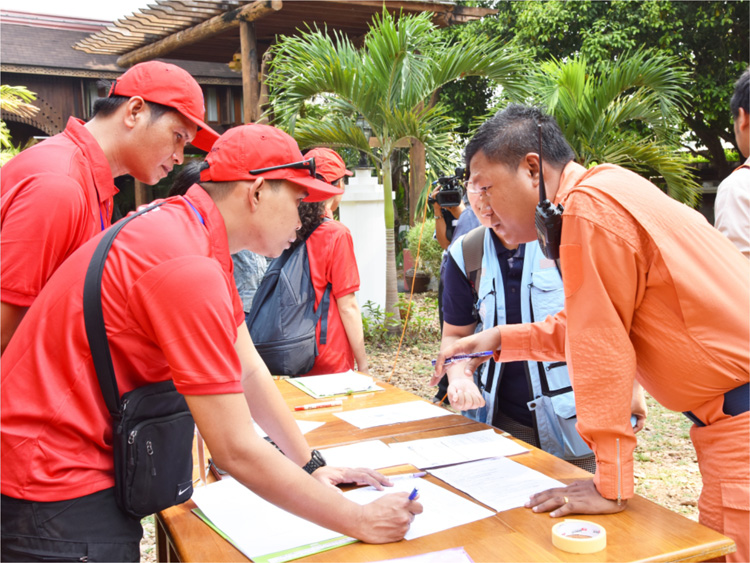Vol 46-The 10th Induction Course of ASEAN-ERAT

THE 10TH INDUCTION COURSE OF
ASEAN-ERAT
For the second time in 2018, the AHA Centre successfully conducted an ASEAN Emergency Response and Assessment Team (ERAT) level 1 course. The 100-hour course was implemented in Bogor, Indonesia during the first week of December 2018, resulting in 19 new graduates, which brings the total pool of talent to 275 deployable ASEAN-ERAT ready to respond to disasters across the region.
“I have been involved in several ASEAN-ERAT trainings and this by far is the most intense one”, said Mr. Sébastien Latouille, the representative from Télécoms Sans Frontières who co-facilitated the course. His remarks was echoed by other facilitators from the AHA Centre, DHL, Indonesian Red Cross, and MapAction. Alongside the continuous course content injections and changes – aimed to resemble the unpredictability of an actual emergency setting – participants also undertook mock-up assessments in mountainous terrain during the midst of a heavy downpour. Thankfully, the ambulance that was on stand-by was not required, as all participants took care of themselves and each other, conducting their work in good health and good shape.
In addition to the regular modules – such as logistic management, information management, rapid assessment, and coordination – a new innovation was integrated to the course design. With the support of DHL Asia Pacific, participants in this course were challenged to coordinate with partners from the private sector. In total, approximately 100 elements were injected during the 48-hour drill, that was a simulation of an emergency response to an earthquake in Metro Manila.
While handing over the signature ASEAN-ERAT vests, Ms. Adelina Kamal, Executive Director of the AHA Centre reminded all graduates that “when you wear the ERAT vest, wear it with pride, but also remember that you are the bridge of trust for ASEAN, and you are the ASEAN’s solidarity on the ground. Always treat fellow ERAT members as your friends, and continue to build strong relationship with them”.
Written by: Shintya Kurniawan | Photo : AHA Centre
- Published in Highlight
Vol 45-ARDEX-18

ARDEX-18
Large-scale disaster responses can be complex in nature, and require the engagement of a wide array of responders, support networks and capacities to ensure the safety of affected communities and pave the way for efficient recovery processes. To prepare for such events, improve procedures, and trial new innovations, every two years ASEAN’s disaster management bodies and practitioners come together to undertake the region’s largest simulation exercise – the ASEAN Regional Disaster Emergency Response Simulation Exercise (ARDEX-18) – that allows all parties to engage, trial and debrief within an atmosphere designed to mirror responses to a relevant large-scale disaster. ARDEX-18, ASEAN’s 7th such simulation, was implemented in Indonesia from the 5th to the 9th of November.
For the first time, 2018’s ARDEX saw the inclusion of hazardous material (hazmat) elements within the overall disaster response simulation, with the exercise focusing on a response to a three-fold disaster situation – namely an earthquake, tsunami and industrial facility damage leading to hazmat leakage – striking the area of Cilegon on the north-western tip of Java island. Cilegon itself has been highlighted by the Indonesian Disaster Management Authority (BPNB) as a high-risk area for such a risk, and therefore provided the perfect backdrop for the added hazmat element within the overall ARDEX-18 exercise. During his address at the opening of ARDEX-18, the then BNPB’s Chief, H.E. Willem Rampangilei, reminded participants of the overall importance of ARDEX events by stating that “ARDEX is an effort to demonstrate ASEAN’s solidarity in increasing disaster readiness, mitigation, and preparedness in Southeast Asia. ARDEX also serves as a platform to enhance our collective capacity and share ideas to attain the best possible disaster management efforts”.
Preparations for ARDEX-18 had been taking place for almost a year, ensuring the integration of a range of ASEAN disaster management procedures and practices including the ASEAN Joint Disaster Response Plan (AJDRP), the ASEAN Standby Arrangements and Standard Operating Procedure (SASOP), the ASEAN Emergency Response and Assessment Team (ERAT), and the guidelines to establish the Joint Operation and Coordinating Centre of ASEAN (JOCCA).
The results of the 5-day exercise will act as the catalyst for improvements and changes to many of these processes, including updating and refining the SASOP and ARDEX handbooks for future exercises. ARDEX-18 also presented the opportunity to engage bodies from both outside the direct disaster management scope, as well as outside the region, to further understand and increase implementation capacity of ASEAN disaster management process and practice, a particularly important element for efficient responses to large-scale disasters. ARDEX-18 was attended by a range of government officials, humanitarian organisations, search and rescue organisations, defence and military officials, private sector representatives, civil society actors, and members of the academic community to improve such broad multi-sectoral partner engagement in ASEAN disaster management activities.
Although faced by the challenges of ongoing disaster responses in Lombok and Central Sulawesi during the lead-up and implementation of ARDEX-18, Indonesia’s BNPB and AHA Centre managed to ensure a fluent and engaging implementation of the exercise, which encompassed a range of formats and workshops under the context of a transnational disaster response.
ARDEX-18 combined both strategic and tactical components, with the simulation exercise including indoor table top discussions between decision makers, in parallel with outdoor command post exercises (CPX) and joint field training exercises (FTX) for humanitarian responders. The real situation of multiple ongoing disaster responses further highlighted the importance and relevance of simulation exercises such as ARDEX-18 for the overall ASEAN, and international disaster management sector.
As stated by the AHA Centre’s Executive Director Ms. Adelina Kamal, “ARDEX is the only regional exercise platform that tests and validates disaster management tools to improve preparedness and readiness for One ASEAN One Response. It also provides a great environment for all of us, including local governments, local communities and stakeholders, to fight against complacency. ARDEX helps us explore the needs as well as acknowledge the capacity of all ASEAN Member States, that will be useful once we are faced with actual emergencies” she explained. As the event wrapped-up on the fifth and final day, all of the 170 participants from across the world had gained further insight into ASEAN’s mechanisms, alongside providing relevant input and sharing ideas and experience for furthering a united ASEAN.
Written by: Shintya Kurniawan | Photo : AHA Centre
- Published in Highlight
Vol 44-ONE ASEAN ONE RESPONSE for Central Sulawesi

ONE ASEAN ONE RESPONSE FOR
CENTRAL SULAWESI
“The tsunami caught everyone in a state of panic. I was near the beach, and everything happened so fast” recalls Misfar, a resident of Palu after a series of disaster events rocked Central Sulawesi on Friday evening the 28th of September, 2018. “The call to prayer began only shortly after the earthquake stopped – and wasn’t yet finished when the tsunami hit the beach”, Misfar explains as he recalls the rapid sequence of multiple disasters that began with a 7.7M earthquake, which was followed by a tsunami and a liquefaction phenomenon. Misfar and his family are grateful to have survived the triple disasters, but remain worried as they lost their houses and feel uncertain about their future.
Misfar is only one of over 68 thousand families whose houses were damaged or ruined by the disasters of the 28th of September. By end of the emergency phase on October 26th, the events caused the deaths of over 2000 people, with over 1,300 still missing, and over 200,000 residents of the Central Sulawesi province displaced. Adding to this, the earthquake also forcibly closed the Mutiara Al-Jufri Airport in Palu, slowing down logistical efforts and the flow of aid to Central Sulawesi’s affected districts (Palu City, Donggala, Sigi, and Parigi Moutong). The earthquake struck within less than two months after a series of seismic events shook the island of Lombok in Eastern Indonesia. The National Disaster Management Authority of Indonesia (BNPB) managed to extend support for both the recovery on Lombok Island, as well as the emergency response in Central Sulawesi.
The Government of Indonesia also opened its doors to welcome offers of international assistance, under specifications identified early during the initial stage of the response. As a result, the international community provided support in a range of forms, including air cargo capacity to transport relief items, water filtration units, family tents, generator sets, medical equipment, and environmental-management support for the prevention of mosquito-borne disease outbreak. At a later stage, the Government of Indonesia also accepted cash donations from governmental and humanitarian partners, channelled through BNPB and the Indonesian Red Cross. Throughout the emergency period, the BNPB worked alongside multiple governmental agencies, who came together on a national response task force. Engaging agencies included the Ministry of Social Affairs, the Ministry of Health, the Ministry of Foreign Affairs, the Ministry of State-Owned Enterprises, the National Search and Rescue Agency, the National Police Force, and the Ministry of Education. The national rapid response was reinforced by local NGOs, as well as volunteers from across the nation, who helped restore stability in the affected sites. In less than one week, the national taskforce managed to gradually restore electricity, telecommunication access, and access to gasoline supplies. Debris cleaning and the provision of health services were also quickly reinforced through the deployment of field hospitals and military vessels from neighbouring provinces and national resources.
“I am impressed by the Government of Indonesia’s work to quickly restore telecommunication and electricity infrastructure. Once the electricity was on, everything else followed, and coordination became easier”, said Kenneth Mak, one of the members of ASEAN Emergency Response and Assessment Team (ERAT) from the Singapore Civil Defence Force who was deployed to Palu in the early days following the disasters.
The AHA Centre responded quickly to the disasters by providing full support as required to the BNPB. In addition to providing relief items, including generators, family tents, and mobile storage units, the AHA Centre also mobilised three groups of ASEAN-ERAT members, with a total deployment of 29 personnel from 5 ASEAN Member States. The Centre also supported BNPB with the facilitation, coordination and tracking of incoming international assistance in Jakarta, Balikpapan, and Palu.
During the second week of the emergency response, the Deputy Prime Minister of Malaysia, H.E. Wan Azizah Wan Ismail, paid courtesy visit to BNPB and the AHA Centre. During this visit, the Chief of BNPB, H.E. Willem Rampangilei mentioned, “We are grateful for the tremendous support of the AHA Centre, who has been very helpful during the responses in Lombok and also Palu”.
In Palu, the AHA Centre and the United Nations Office for the Coordination of Humanitarian Affairs (UNOCHA) had the opportunity to implement ASEAN-UN interoperability of mechanism for the first time. On immediate notification, ASEAN-ERAT was assigned by BNPB to set-up and manage the on-site Joint Operations and Coordination Centre for International Assistance (JOCCIA), which is home to facilitate the initial joint needs assessments involving both national and multinational agencies. At a later stage, the ASEAN-ERAT and JOCCIA also hosted members of the United Nations Disaster Assessment and Coordination (UNDAC) Team. The widespread impact and scale of the disaster attracted the attention of the United Nations Secretary-General, H.E. António Guterres, who visited ground-zero on the 12th of October. Prior to the visit, he addressed ASEAN Leaders in Denpasar, reiterating the full commitment of the United Nations to support government-led rescue and relief efforts. “I also commend the work of the ASEAN Coordinating Centre for Humanitarian Assistance which has been instrumental in the response, even facilitating and accommodating some of our embedded UN staff.”
The collaboration for the response in Central Sulawesi was comprehensively summarised by ASEAN-ERAT member from the Singapore Civil Defence Force, Mr. Nazim Bin Kudin, when he stated that “everyone came together to help one another, and the best type of leadership is by setting examples, instead of simply telling one another what to do”. He continued by saying that “leading by example not only indicates that you are in-charge, but also the fact that you are involved in getting the work done. So, once you roll-up your sleeves, everyone will follow. That is what I witnessed from the excellent partnership here, especially with the logistics management team.”
Written by: Shintya Kurniawan | Photo : AHA Centre
- Published in Highlight
Vol 43-ONE ASEAN ONE RESPONSE for Typhoon Mangkhut

ONE ASEAN ONE RESPONSE
FOR TYPHOON MANGKHUT
By mid-September it was all-hands-on-deck in the AHA Centre, with the monitoring team tracking the formation of largest storm cell of the year so far, as it made its way across the Pacific Ocean with a population of millions across the Philippines directly in its path. Communities along the nation’s northern coastline and outer islands were being evacuated, as preparation was well underway for the onset of Super Typhoon Mangkhut (Ompong). On the 15th of September, Typhoon Mangkhut made landfall in Cagayan Province, continuing its path westward with extreme winds and lashing rain, and leaving in its trail over 2.5 million people affected across the Philippines.
Afterwards, a total of 8 provinces and seven cities/municipalities have been announced under state of emergencies, with widespread damage to homes, infrastructure and livelihoods. Typhoon Mangkhut – that had an actual diameter larger than 2013’s Typhoon Haiyan – claimed over 50 lives, with hundreds more injured, and over 180,000 homes either fully or partially damaged. Total damage has been estimated at over USD 6 million, with communities particularly affected by secondary hazards that accompanied the typhoon, such as flooding and landslides. However, was it not for the coordinated effort in the days prior to the storm by the various national and sub-national agencies, alongside communities themselves, loss of life and damage could have been far worse.
“We pre-positioned the Cagayan Valley Response Team in advance, with early evacuation taking place two days prior to the typhoon’s landfall. We also estimated the numbers of people likely to be affected, and provided hygiene kits, non-food items, and generators. These preparedness measures managed to minimise casualties in our region”, explained Mr. Dante Balao, the Regional Director of Office of Civil Defense (OCD) Regional Office II, in Tuguegarao, Cagayan.
Alongside tracking the progress of Typhoon Mangkhut in the weeks and days leading-up to the disaster, the AHA Centre was also engaged with the Philippines Government, through the Philippines’ National Disaster Risk Reduction and Management Council (NDRRMC), in both the preparation and response to the storm. At a later stage, the ASEAN Emergency Response and Assessment Team (ERAT) was mobilised to provide information management and assessment report as the emergency phase coming to an end. On the 15th of September, just hours after the typhoon made landfall, the AHA Centre In-Country Liaison Team arrived in the Philippines, to establish direct communication with the NDRRMC in Manila and in affected areas, and to facilitate ASEAN’s assistance to those in need.
In response to the disaster, the AHA Centre mobilised relief items valued at over USD 275,000 to communities across the affected regions, including 30 tonnes of rice, four generator sets, and 2,000 rolls of tarpaulins. During the handover ceremony on September 24th, Undersecretary Ricardo B. Jalad, the Executive Director of NDRRMC and the Administrator of the Philippines’ Office of Civil Defense showed his appreciation for ASEAN’s support when he stated “I would like to thank and express my deep gratitude to the AHA Centre for facilitating this assistance”.
While Typhoon Mangkhut was a disastrous event for the Philippines and the ASEAN region, it presented an opportunity for the AHA Centre and ASEAN-ERAT to engage on a new element as part of the region’s ongoing efforts to improve disaster management practices. Three ASEAN-ERAT information management specialists were deployed to support the NDRRMC office with data analysis, data visualisation and report writing. One of the ASEAN-ERAT Level 2 members deployed to the Philippines, Adiratna Wira from Malaysia, recognised the importance of information management support for response agencies during disasters. “Aside from the actual products developed, there was great benefit for both the NDRRMC and ASEAN-ERAT members”, said Adiratna. “There was increased understanding in the roles and ways of working for each party, which could speed-up a range of processes and information distribution in the future.”
On the last day of the ASEAN-ERAT’s deployment, Mr. Edgar Posadas, the Director of Operations Service and Spokesperson of the NDRRMC emphasised, “we know that our region is always at risk of disasters, but with neighbours like you and friends like you, we know that things will be moving forward. We are thankful to our ASEAN neighbours and the AHA Centre for your help. The ASEAN region is advancing, we don’t have to go beyond our borders (to respond to disasters), so those beyond the ASEAN corridors can attend to their own disasters. I think it’s a way to go now, everybody is trying to be self-sufficient. We have to be ready should simultaneous disasters are taking place. So, the more capacity that we have and the more prepared we are, the better it will be for the people”.
Written by: Shintya Kurniawan | Photo : AHA Centre
- Published in Highlight
Vol 42-ONE ASEAN ONE RESPONSE for Lombok

ONE ASEAN ONE RESPONSE
FOR LOMBOK
During August 2018 the AHA Centre once again evidenced ASEAN’s solidarity for disaster-affected population in the Southeast Asian region, this time supporting communities in the well-known tourist destination of Lombok, West Nusa Tenggara, Indonesia. The area was recently the epicentre of multiple earthquakes, with the initial major quake recorded at M 6.4 on Sunday the 29th of July. A week later, on the 5th of August, a larger M 7 earthquake hit the already-affected area, increasing numbers of casualties and causing greater damaged to buildings and livelihoods within the Lombok region. The main shock also triggered a tsunami warning, which thankfully did not result in an actual tsunami event. However, throughout the month of August, over 1000 aftershocks were recorded by the Meteorological, Climatology, and Geological Agency of Indonesia (BMKG), with the region still remaining vulnerable to quakes during the ongoing recovery phase.
Following the main earthquake on the 5th of August 2018, the AHA Centre intensified its cooperation with Indonesian National Disaster Management Authority (BNPB), which had been ongoing since the initial quake in late July. Upon receiving notification of the second earthquake, the AHA Centre immediately deployed a staff member to the field, provided information management and translation support for BNPB, as well as facilitated the deployment of an ASEAN Emergency Response and Assessment Team (ERAT) to the affected region. A little later, the AHA Centre obtained a green-light to mobilise relief items from the ASEAN emergency stockpile in Subang, Malaysia. These relief items – worth approximately USD $154,438 – were picked-up by the BNPB using a chartered flight, arriving in Praya Airport, Lombok, in three batches between early to mid-August.
For Lombok, earthquake events are not particularly new, with notable earthquakes recorded in the region from as early as the year 1856. Consolidated data from the United States Geological Survey and the Indonesian Meteorological and Climatology Agency (BMKG) also noted that major earthquakes above M 6 occurred on the island in 1970, 1972, 1978, 1979, and 2000. Based on the latest National Disaster Risk Index – published by BNPB in 2016 – Lombok is categorised as a medium to high-scale earthquake-prone area. Considering these vulnerabilities and risks, the resettlement areas currently underconstruction will use similar earthquake-resistant technology that has been adopted through the post-earthquake recovery periods in Aceh and Nias, Sumatera, Indonesia.
“Indonesia is part of the ASEAN community, and the BNPB has been working closely with the ASEAN coordinating agency for disaster management, or AHA Centre. All Heads of State and Government of ASEAN countries have agreed to stand as one, whenever natural disasters happen in neighbouring states. Based on the One ASEAN One Response Declaration, Indonesia trusts the AHA Centre to provide additional logistical support that is required for the emergency response. For example, this Mobile Storage Unit we stand in that can serve as a portable warehouse, and family tents that can provide shelters for the displaced communities”, said H.E Willem Rampangilei, the Chief of BNPB, in between the emergency responses in Lombok.
On a similar note, the Executive Director of the AHA Centre, Ms. Adelina Kamal, stated that “the ASEAN relief items belong to all ASEAN countries, including Indonesia. When a disaster occurs and relief items are required, ASEAN Member State can access the regional stockpile, and the AHA Centre will facilitate its mobilisation to the affected areas. We would like to show our appreciation to the BNPB for the confidence given to the AHA Centre in complementing the government’s life-saving efforts on the ground. Our partnership strengthens the vision embodied in the ASEAN Declaration on One ASEAN One Response”.
All ten ASEAN Member States have recognised the AHA Centre as the primary regional disaster management coordinating agency in ASEAN. Indonesia has been actively involved in the establishment of the AHA Centre, and has been hosting the AHA Centre since it first opened in November 2011. The mission to Lombok is the AHA Centre’s fifth response this year, bringing the total responses to 23 emergencies in 7 ASEAN countries since the AHA Centre’s establishment.
Written by: Shintya Kurniawan | Photo : AHA Centre
- Published in Highlight
Vol 41-Response to Tropical Storm 11

RESPONSE TO
TROPICAL STORM 11
The formation of Tropical Storm 11 (TS 11 – also known as Son Tinh, or Henry in the Philippines) had been closely monitored by the AHA Centre since early July 2018, as the team worked alongside the National Disaster Management Organisations of ASEAN Member States to prepare for the potential disaster impacts that may materialise should the storm continue to gain strength. Towards the end of July, TS 11 intensified, with torrential rains and strong winds buffeting a number of nations, including Cambodia, Lao PDR, Myanmar, the Philippines, Thailand, and Viet Nam, resulting in widespread flooding through many districts within these nations. By the end of July, the AHA Centre was engaged in two disaster responses to flooding in both Lao PDR and Myanmar – which stands as the first time the AHA Centre provided support to two different ASEAN nations in unison.
Floods were being reported across numerous ASEAN countries in the aftermath of TS 11. However, in the of evening of July 23rd, the walls of Xe Pien and Xe Nam Noy dams in Lao PDR burst, with flash floods impacting thousands of households downstream from the large water catchments. Within 24 hours, the AHA Centre’s Emergency Operations Centre (EOC) in Jakarta activated its emergency response operations, and an In-Country Liaison Team (ICLT) was deployed and arrived in Vientiane. For this response, the AHA Centre provided four key aspects of assistance to the Government of Lao PDR and its people, including logistical management and coordination, information management and mapping, advisory support for operations planning, and finally mobilisation of relief items.
During the handover, the AHA Centre’s Executive Director, Ms. Adelina Kamal, stated that “The spirit of One ASEAN One Response is well-demonstrated in times of crisis, such as today. The swift coordination is enabled through continuous partnerships between NDMOs of all ASEAN Member States and our partners, built over the years under ASEAN cooperation on disaster management”.
ASEAN’s relief items were delivered by the AHA Centre on both the 27th and 29th of July. The first batch included 1 alumunium rescue boat, 150 family tents, 2616 hygiene kits, alongside a mobile storage unit for use as a temporary warehouse for all incoming relief items. In addition, the National Disaster Management Agency of Malaysia (NADMA) also added to the assistance by providing an extra alumunium rescue boat. Whereas the first batch of relief items were flown-in to Wattay International Aiport in Vientiane, a second batch comprised of 3500 mosquito nets were delivered alongside Australian relief items, directly into Pakse Airport, Attapeu, one of the province’s hardest hit by the natural disaster. The mobilised relief items are crucial to the specific needs of Lao PDR’s NDMO, as well as the affected population.
“When we found out that we had a serious disaster, like the dam collapsing, the first thing that came to mind was the AHA Centre. Emergency response is not only about mobilisation of funds, materials and food. We also need to learn about coordination for medical support, military cooperation, and camp management. I would like to take this opportunity to train people and learn how to organise, starting from the village level”, said Mr. Prasong Vongkhamchanh, the Director-General of Social Welfare Department of Lao PDR’s NDMO, during a briefing with the AHA Centre’s ICLT.
Overall, TS 11 and the resulting flooding affected 10 out of 17 provinces across Lao PDR. On the 28th of July, the ASEAN Secretary-General – H.E. Dato Lim Jock Hoi, Deputy Secretary-General for ASEAN Socio-Cultural Community – H.E. Vongthep Arthakaivalvatee, the Director-General of Social Welfare Dept. Head of NDMO Lao PDR – Mr. Prasong Vongkhamchanh, and the Executive Director of AHA Centre – Ms. Adelina Kamal, visited one of the severely affected provinces, handing over ASEAN’s assistance to the Governor of Attapeu and the Mayor of Sanamxay District.
“Being forced from our homes is not a choice anyone desires for oneself, nor impose on others. The storm may have rendered our lives tragic and difficult, but we shall weather it through the triumph of our spirit”
said the Secretary-General of ASEAN, H.E. Dato Lim Jock Hoi, upon his visit to Sanamxay.
Before the mission in Lao PDR was concluded, monsoonal conditions in Myanmar saw the AHA Centre launch its second response on the 30th of July, to support the Government of Myanmar as nine regions/states were inundated by floodwaters, damaging homes and threatening lives in the central and southern states of the country. As conditions worsened, more and more of the nation’s population felt the brunt of the monsoon, with the Government of Myanmar reporting that more than 150,000 people had been internally displaced floods and landslides across nine regions, with the regions of Bago, Kayin, Mon, and Tanintharyi most heavily impacted. With many of the affected communities living in rural areas, a key issue highlighted was the limited electricity supply. To address this, the AHA Centre provided 12,000 portable solar lanterns, procured locally at a value of approximately USD $79,883 that were then distributed to communities facing power outages throughout the flooded nation. These items, alongside the provision of an In-Country Liaison Team to support Myanmar’s NDMO, displayed the solidarity of the ASEAN region as it provided disaster relief assistance, through the AHA Centre, to the communities affected by flood in Myanmar. The relief items were received by Mr. Win Shwe, Yangon Director of Department of Disaster Management, Ministry of Social Welfare, Relief and Resettlement Department, in Yangon, Myanmar on the 3rd of August 2018. During the handover ceremony, Mr Win Shwe emphasised Myanmar’s gratitude by saying, “We would like to convey our deepest appreciation to AHA Centre for its readiness to support Myanmar. By taking this opportunity, we would also like to extend our personal thanks to the Government of Japan for its generous donation to ASEAN, through the Japan-ASEAN Integration Fund. This assistance will definitely signify the unity and friendship amongst the ASEAN Member States and would enhance mutual understanding”.
The mission in Myanmar was concluded on the 4th of August 2018, with the overlapping responses forming the first time that the AHA Centre has activated missions to different countries at the same time. Although the ASEAN Emergency Response and Assessment Team (ERAT) was not activated for both responses, the AHA Centre managed to obtain the support of a Yangon-based ASEAN-ERAT personnel, who volunteered to help the AHA Centre’s ICLT during their mission in Myanmar. With less than 30 personnel, the AHA Centre also managed to gain ad-hoc support from various partners. At the end of its first ever in-unison response, the AHA Centre was already gearing up to support a Government-led emergency response in the earthquake-affected areas in Lombok, Indonesia, of which will be detailed in the next edition of the AHA Centre’s Column.
Written by: Shintya Kurniawan | Photo : AHA Centre
- Published in Highlight
Vol 36-ASEAN-ERAT Mission in Rakhine, Myanmar

ASEAN-ERAT
MISSION IN RAKHINE, MYANMAR
As part of its ongoing efforts to assist displaced population in Myanmar’s Rakhine State, the AHA Centre deployed ASEAN Emergency Response and Assessment Team (ASEAN-ERAT) personnel to Myanmar from the 15th – 31st of January, 2018. Tasked to support the work of the Disaster Management Department of Myanmar, the deployed ERAT team was made up of members from the Philippines and Singapore, alongside one AHA Centre staff.
THIS DEPLOYMENT OF ASEAN-ERAT PERSONNEL HAD THREE PRIMARY OBJECTIVES:
1. Observing the status of ASEAN’s relief items that were previously provided through the AHA Centre;
2. Supporting the Emergency Operations Centre (EOC) of Myanmar’s Disaster Management Department with information management, secondary data analysis, and report writing;
3. Undertaking preparations for the next ASEAN-ERAT Induction Course that will be held in Myanmar later in 2018.
Between October 2017 and January 2018, the AHA Centre facilitated the provision of 80 tonnes of relief items, delivered in two batches from the ASEAN regional stockpile in Subang, Malaysia. In December 2017, additional relief items were locally procured by utilising a S$100,000 contribution from the Government of Singapore. Part of this deployment mission included a two-day field observation to Rakhine State, through which the ASEAN-ERAT members confirmed that the distribution of relief items was undertaken as reported by the Disaster Management Department of Myanmar.
The ASEAN-ERAT team also observed the state of temporary shelters, prepared by the Government of Myanmar for displaced communities in Rakhine, as well as those that may return from outside the State. This temporary settlement is equipped with clean water, as well as pre-positioned materials such as clothes, food, and kitchen sets.
In addition to the existing efforts, the Government of Myanmar has developed a stockpile of contingency relief items in Sittwe and Maungdaw, in anticipation of future events, such as flooding, during the approaching monsoon season. Throughout their mission, the ASEAN-ERAT members worked closely with the Director-General and staff of the Disaster Management Department, alongside the Myanmar Red Cross, the General Administration Department in Rakhine, and the Fire Services Departments in Nay Pyi Taw, Yangon, and Rakhine. They worked together conducting a needs assessment, and developing recommendations to further enhance the ongoing provision of humanitarian assistance to the affected communities in Rakhine State.
“THE AHA CENTRE WOULD LIKE TO THANK THE GOVERNMENT OF MYANMAR FOR WELCOMING OUR ASEAN-ERAT MEMBERS TO WORK IN NAY PYI TAW AND RAKHINE STATE. THE MISSION DEMONSTRATES ASEAN’S SOLIDARITY, HELPING ONE ANOTHER IN TIMES OF DIFFICULTY, UNDER THE SPIRIT OF ONE ASEAN ONE RESPONSE,” SAID ADELINA KAMAL, EXECUTIVE DIRECTOR OF THE AHA CENTRE.
Written by : Shintya Kurniawan | Photo : AHA Centre
- Published in Highlight
Vol 40-The 8th Meeting of The Governing Board of The AHA Centre

THE 8th MEETING OF
THE GOVERNING BOARD OF THE AHA CENTRE
The latest series of meetings of the ASEAN Committee on Disaster Management (ACDM) and the Governing Board of the AHA Centre focused towards the continuing vision of ASEAN nations to become global leaders in disaster management. The meetings discussed a number of ongoing initiatives, as well as past achievements in disaster management, alongside the future disaster management plans for the ASEAN region.
This integral series of meetings was officially opened by Malaysia’s Deputy Prime Minister, the Honourable Dato’ Seri Dr. Wan Azizah binti Wan Ismail, who commended ASEAN on its various achievements in disaster management, while also reiterating the work that still must be done. She highlighted particular concerns regarding the plight of women during disaster situations, calling on ASEAN nations to continue efforts to mainstream gender within disaster management efforts.
Achievements highlighted by the Governing Board included the decision that the AHA Centre would provide humanitarian assistance support to the survivors of human-induced disasters. Throughout 2017, and continuing into 2018, the AHA Centre provided humanitarian assistance to displaced populations in Marawi, the Philippines and the Rakhine state, Myanmar. This evidenced the AHA Centre’s efforts to ‘go the extra mile’, as the original mandate of the AHA Centre focuses on providing assistance to victims of natural disasters. In this situation however, the AHA Centre recognised the need to be adaptable and flexible in recognition of the ever-evolving landscape and increasing complexity of disaster management in the region.
During the meeting, ASEAN nations also reaffirmed their commitment to support the operationalisation of One ASEAN One Response Declaration – signed in 2016 – that calls for an increase in speed, scale and solidarity of ASEAN collective response to major disaster within and outside the ASEAN region. The AHA Centre, as the operational engine of the ASEAN Agreement on Disaster Management and Emergency Response (AADMER), has taken a number of initiatives to further enhance the operationalisation of the Declaration, including the formulation of the ASEAN Joint Disaster Response Plan (AJDRP).
Another highlight from the meetings were the various initiatives to improve the capacity of the disaster professionals in the region through various capacity building activities, including the ASEAN Emergency Response and Assessment Team (ASEAN-ERAT) training, as well as the AHA Centre Executive (ACE) Programme. In addition to this, ASEAN is currently working to kick-start the ASEAN Standards and Certification for Experts in Disaster Management (ASCEND). Through this programme, ASEAN aims to set common standards and qualifications for disaster management professionals, as well as develop a standard training curriculum. By agreeing on common standards, ASEAN will ensure the availability of qualified disaster management professionals in the region, further supporting the vision of ASEAN becoming a global leader in disaster management.
On the side-lines of the event, the Governing Board also witnessed the signing of three Memoranda of Intent (MoI) between the AHA Centre and key strategic partners – namely MERCY Malaysia, RedR Australia and MapAction.
These MoI signings signify the commitment between AHA Centre and the partners to further strengthen, compliment and support each other in areas of mutual interest on disaster management. Several areas covered under the MoIs include knowledge exchange and management, innovation and joint fundraising efforts, disaster monitoring and analysis, and recovery.
All of these were discussed during the 32nd Meeting of the ACDM and other related meetings that took place from the 26th to the 28th of June 2018, in Kuala Lumpur, Malaysia. This also included the 8th Meeting of the Governing Board of the AHA Centre on the 27th of June, the 9th Meeting of the Joint Task Force to Promote Synergy Other Relevant ASEAN Bodies on Humanitarian Assistance and Disaster Relief (HADR), and the 5th ASEAN Agreement on Disaster Management and Emergency Response (AADMER) Partnership Conference. During this event, the AHA Centre also presented its 2017 Annual Report, which documents the progress, achievements, and plans for further enhancement of the roles and responsibility of the AHA Centre.
Written by: Carla Budiarto, Dipo Summa | Photo: AHA Centre
- Published in Highlight
Vol 37-ASEAN Workshop on The Implementation of ONE ASEAN ONE RESPONSE

ASEAN WORKSHOP
ON THE IMPLEMENTATION OF ONE ASEAN ONE RESPONSE
Remaining focused on responding to natural disasters in the ASEAN region, alongside planning for facilitating potential collective ASEAN responses outside of the region form the key recommendations for the AHA Centre. These points were deliberated by participants of the ASEAN Senior Official Multi-Sectoral Workshop on One ASEAN One Response, organised by the ASEAN Secretariat, from the 27th to 28th of March 2018. Representatives from a wide range of ASEAN sectoral bodies attended the workshop, including from the Country Permanent Representatives (CPR), the ASEAN Committee on Disaster Management (ACDM), representatives from the Senior Official Meeting (SOM), ASEAN Defense Senior Official Meeting (ADSOM), Senior Official Meeting on Health Development (SOMHD), Senior Official Meeting on Social Welfare and Development (SOMSWD), as well as other relevant ASEAN entities and partners.
The principal purpose of this meeting–as highlighted by the ASEAN Secretary-General H.E. Lim Jock Hoi during his opening address–was to engage the views of a range of stakeholders in more prominently defining the functions of the Declaration, as well as providing clarity to requirements for current and future humanitarian challenges faced by the ASEAN region.
The One ASEAN One Response Declaration, signed by the ASEAN Leaders in 2016, reaffirms the commitment of ASEAN nations to respond collectively to major disasters in the region as one, in order to achieve faster speed, greater resources and stronger coordination. It also reaffirms the position of the AHA Centre as the primary regional coordinating agency on disaster management and emergency response, as well as tasks the AHA Centre to establish coordination mechanisms with other East Asian Summit (EAS) participating countries to enable them to provide assistance to ASEAN countries affected by disasters. The Declaration also envisions a future where ASEAN countries can collectively provide assistance to countries outside of the ASEAN region, and tasks the AHA Centre with preparing for such engagement.
The AHA Centre used this opportunity to update workshop participants on recent progress made by the AHA Centre in operationalising the One ASEAN One Response Declaration. The Director of Operations of the AHA Centre, Arnel Capili, presented a range of tools and concepts that the AHA Centre has developed throughout recent years, supported by strategic guidance from the ACDM. Such processes, amongst others, include the Joint Operations and Coordination Centre of ASEAN (JOCCA), the Web Emergency Operation Centre (WebEOC), and the Disaster Monitoring and Response System (DMRS). However, the most important of all is the ASEAN Joint Disaster Response Plan (AJDRP), which contains a list of earmarked assets and capacities of ASEAN Member States that may be voluntarily mobilised to support countries affected by disaster.
The operational focus of the AHA Centre also formed a key subject of discussion during the workshop, with many participants seeking clarification on the AHA Centre’s future role responding to human-induced disasters, as an addition to natural disaster response. Participants finally agreed that AHA Centre should remain focused on natural disasters, with potential human-induced disaster response to be decided on case-by-case basis and with limited focus only on providing immediate humanitarian assistance in such cases. All the points of discussion were summarised into a 16-point recommendation list to be presented to the next meeting of the ACDM in June 2018.
The Executive Director of the AHA Centre, Adelina Kamal, thanked all the ASEAN Member States for their continued and ongoing support for the AHA Centre. She nevertheless highlighted that there is still much work to do, including increasing the contribution of other sectors in ASEAN for the AJDRP, as well as pushing for broadened participation of the private sector and civil society in the AJDRP.
The AHA Centre launched and introduced a new handbook titled “Operationalising One ASEAN One Response: Speed, Scale, Solidarity” at the workshop, which serves as a reference for operationalising One ASEAN One Response.
Written by : Dipo Summa | Photo : AHA Centre/Shintya Kurniawan, ASEAN Secretariat
- Published in Highlight
Vol 38-The 9TH ASEAN-ERAT Induction Course

THE 9TH ASEAN-ERAT
INDUCTION COURSE
Ten years since its first ASEAN-ERAT deployment – to support the response to Cyclone Nargis in Myanmar – the AHA Centre conducted its 9th ASEAN-ERAT Induction Course from the 26th of March until the 1st of April 2018, in Nay Pyi Taw, Myanmar. With outstanding support from the Department of Disaster Management of Myanmar (DDM) as the host, the course was attended by 31 participants from nine of the ten ASEAN Member States. Participants came from an array of backgrounds, including National Disaster Management Organisations, Red Cross and Red Crescent Societies, Civil Society Organisations, Youth Groups, the ASEAN Secretariat, ASEAN Plus Three Emergency Rice Reserve (APTERR), and the AHA Centre itself. The 9th ASEAN-ERAT Induction Course was officially opened with an inspiring speech by Dr. Win Myat Aye, the Union Minister of Social Welfare, Relief and Resettlement of Myanmar.
One of the key features of the 9th course was the simulation exercise scenario – which engaged one of the ASEAN Contingency Plans for large scale disaster – namely a 7.2 magnitude earthquake in Metro Manila. Using this contingency plan scenario, the simulation exercise increased the feeling of authenticity for participants as they performed the ASEAN-ERAT core functions, including rapid damage and needs assessments and incoming ASEAN relief item facilitation. They also enacted the provision of on-site coordination support to the affected country’s local authorities, namely through the facilitation of coordination meetings between a range of ground-level stakeholders.
The simulation exercise also allowed ASEAN-ERAT participants to develop their working relationships with the United Nations Disaster Assessment and Coordination (UNDAC) team, as part of the continued development of inter-operability between the Joint Operations and Coordination Centre of ASEAN (JOCCA) and the UN On-site Coordination Centre. Other components including personnel and team safety and security, as well as working with media were also tested during the simulation exercise. By simulating this response as part of the ASEAN-ERAT course, the AHA Centre has further enhanced the streamlining and capacity of ASEAN-ERAT within the ASEAN Contingency Plan development process.
Of particular note was the enthusiasm and spirit of the participants to deliver results during the non-stop, 48-hour simulation exercise. Given its intensity, the diversity of participants’ backgrounds, and varying skills across the different nationalities, the final results were considerably strong. These diversities and challenges were raised throughout the debrief session, often identified as considerable factors in shared-learning and strengthening the team.
Participants also valued the engagement of a range of external parties, including the United Nations Office for the Coordination of Humanitarian Affairs (UNOCHA), the International Red Cross/Crescent Societies (IFRC), Map Action, Télécoms Sans Frontières, and Myanmar Red Cross amongst others, which provided them the opportunity to familiarise themselves with other key actors who would work alongside them in the field. This also allowed participants to see the importance of stakeholder engagement in achieving the vision of One ASEAN, One Response within the ASEAN-ERAT programme.
The successful completion of the 9th ASEAN-ERAT Induction Course, supported by the Japan-ASEAN Integration Fund (JAIF), alongside other previously-mentioned implementation partners, sees a current pool of 252 ASEAN-ERAT members across the region. Graduates were inaugurated during the Closing Ceremony by Ms. Adelina Kamal, Executive Director of the AHA Centre, together with the Deputy Minister of Social Welfare, Relief and Resettlement of Myanmar, Dr. U Soe Aung and Director General of DDM of Myanmar, Dr. Ko Ko Naing.
“We believe that the benefit of the ASEAN-ERAT goes beyond disaster response and that, because the ERAT teams are composed of government and NGO staff, participants are able to learn skills and get awareness of technologies and practices to take home and use in their current and future projects” – Sebastien Latouille, Delegate of Télécoms Sans Frontière.
“All of the new graduates should feel a great sense of pride. This very demanding course tested each of them and they all came through!” – Oliver Lacey-Hall, Head of UN-OCHA Indonesia/ASEAN Liaison Office.
“During the training, we made mistakes under the stress of the situation. But we could correct our mistakes and overcome the stress by working together and supporting each other as a team. We really appreciate the patience of our facilitators and mentors, for teaching us, for staying with us in the SimEx and sharing your knowledge and expertise with us” – Chan Nyein Thu, ASEAN-ERAT member Batch 9, Department of Disaster Management, Myanmar.
Written by: Grace Endina | Photo: AHA Centre
- Published in Highlight

